Nick Milligan's Blog, page 4
January 31, 2017
Hidden Figures: review
HIDDEN FIGURES
Director: Theodore Melfi
Rating: 3/5
When Hollywood’s not unashamedly rehashing the ideas of old, it’s desperately seeking forgotten tales from history – small but important stories that never received the recognition they deserved.
Such a story is contained within the second film from director and Brooklyn-native Theodore Melfi, Hidden Figures. It’s a heart-warming tale about three women of extremely high-intellect. They’re physicist and mathematician Katherine Johnston (nee Goble), mathematician and computer programmer Dorothy Vaughan and aerospace engineer Mary Jackson.
Their story is a remarkable one, not just because they were women at a time of blatant sexism, and not merely due to being African-American at a time of appalling racial segregation. But the real interest here lies in the fact that their mathematical and visionary contributions were crucial to America’s race against Russia to put the first man on the Moon.
Johnston (Taraji P. Henson), Vaughan (Octavia Spencer) and Jackson (Janelle Monaé) are friends and colleagues working at NASA. The year is 1961, three years before the Civil Rights Act of 1964 will deal a fatal blow to the legal oppression of African-American people in the United States. Each woman is incredibly strong-willed and, as history demonstrates, a true trailblazer.
Johnston’s gifts for analytical geometry see her become the first African-American women to join NASA’s Space Task Group, where she works under the crusty but ultimately kind Al Harrison (Kevin Costner) and alongside snivelling head engineer Paul Stafford (Jim Parsons).
Vaughan is the informal supervisor of NASA’s West Area Computers, a group of female African-American mathematicians that are called upon as computers. She works under the cold and watchful eye of supervisor Vivian Mitchell (Kirsten Dunst). When the first IBM 7090 computer arrives at Langley, Vaughan sees the writing on the wall and cleverly educates herself in computer programming, quickly training the women in her office and making them all equally indispensable.
Jackson wants to rise within the engineering ranks at NASA, but requires an engineering degree from an all-white school. She will have to convince a judge to allow her special permission to do so.
Based on the non-fiction book Hidden Figures: The Story of the African-American Women Who Helped Win the Space Race, by Margot Lee Shetterly, published only last year, Hidden Figures takes a rosy, sanitised, Hallmark approach to its subject matter. It largely deals with the inherent racism faced by the three women with playful humour (the ludicrousness of Johnston’s 40-minute round trip to the only “Colored Ladies Bathroom” on the other side of the NASA compound is used as a comic device, and hammered home on a number of occasions). That said, when Johnston is provided her own coffee jug so as not to share the brew of her fellow workers, it is a sobering moment.
…Costner’s hard-ass-with-a-heart-of-gold boss dramatically tears the “Colored Ladies Bathroom” sign off the wall with a crowbar (curiously, with a wide-eyed crowd looking on), declaring poetically: “Here at NASA, we all pee the same color.” Why this is not the movie’s poster tagline, I don’t know.
The white characters of Hidden Figures, each a product of their times, are typically mean to our heroines to begin with, but ultimately see the error of their ways. Astronaut John Glenn (played with roguish charm by Glen Powell) is every bit the saintly and handsome all-American hero, sweet and kind to our protagonists from their first meeting.
In one of the film’s great contrivances (due to the fact that segregated facilities had been abolished within NASA by 1961), Costner’s hard-ass-with-a-heart-of-gold boss dramatically tears the “Colored Ladies Bathroom” sign off the wall with a crowbar (curiously, with a wide-eyed crowd looking on), declaring poetically: “Here at NASA, we all pee the same color.” Why this is not the movie’s poster tagline, I don’t know.
Melfi follows his debut movie, St. Vincent, with a film that knowingly pushes every emotional button, wringing every drop of sentiment from its unquestionably important subject matter. This is indeed a story worth telling, and sheds overdue light on this trio’s contribution to history. Hidden Figures is inherently inspiring, and the cast is invested and convincing, despite the heavy handed manipulations of the script.
But it’s a shame that the screenplay’s treatment is so resolutely saccharine and Melfi’s approach is void of any recognisable cinematic aesthetic. This is midday telemovie territory.
Despite its short-comings, Hidden Figures will be the dark horse at this year’s Academy Awards. Watch this space.


December 31, 2016
Top 20 Records of 2016
The Peep Tempel
Jesus, what a year for music.
Especially for Australian songwriters. As you’ll discover from the below list, seven of the 10 best records made in 2016 were by Aussies (50% of the top 20 is Australian). Amongst them are one master and six artists of a newer generation, each crafting some truly classic material. The future of Australian stories are in safe hands.
It was notably a year of sterling returns by a number of ’90s legends. The new offerings from Wilco, Teenage Fanclub, Dinosaur Jr and Pixies were very close to making the cut, but you’ll notice the esteemed rankings of the fresh albums from Nada Surf and The Jayhawks.
Some rising Australian stars gave us a lot to be excited about this year too. Particularly two songwriters by the name of Melody Pool and William Crighton, who both released truly incredible records. More established artists, such as The Drones and Liz Stringer, made the elusive arts of consistency and evolution seem very easy to obtain.
Much has been made of the legends we lost in 2016. Particularly painful for me was the departure of the incomparable Leonard Cohen, the greatest lyricist to have ever lived. His swan song, You Want it Darker, very nearly made this list. But while it was another peerless lyrical showing, melodically it didn’t arouse me as much as his previous work. But he is still one of the all-time greats – the lord and master.
So while we might lament the legion of superstars that ascended into the annals of music mythology, calling in their status as immortals, we’re all still here – and we’ve been left with some glorious music. I listen therefore I am.
Enjoy.
[image error]20. DOPE LEMON
Honey Bones
In June this year Angus Stone finally got around to dropping the breezy bedroom project he’d been slowly piecing together over many years. The result was, as the name suggested, pretty dope. In fact, at about the mid-point of opener ‘Marinade’, the idea that this was Stone’s finest work didn’t seem all that big a claim.
On Honey Bones, Stone manages to out-slack Kurt Vile with a cohesive psych-folk collection that’s so dreamy it’s on the brink of deep slumber. There’s some sweet experimentation too, with drops of trip-hop on ‘The Way You Do’ and shimmering dream-pop on the exquisitely serene ‘Won’t Let You Go’. They’re zesty elements in an always interesting and catchy record that expands and unfolds with repeated listens, and is a perfect marriage with Stone’s laconic vocals. Dope Lemon is a project worthy of further exploration – let’s hope it’s not a one off.
[image error]19. CHILDISH GAMBINO
“Awaken, My Love!”
A progressive psychedelic neo-soul space odyssey – void of any actual rap music – was not what Donald Glover’s legion of disciples would have expected from his follow-up to 2013’s impressive sophomore effort Because the Internet. But “Awaken, My Love!”, as his third record is maniacally titled, is certainly something left of centre.
Showing off his impressive range as a singer, Glover sounds like a man possessed, shape-shifting across every track, an artist with multiple personality disorder. Exorcising demonic funk and RnB entities, he’s either wailing as if in the throws of a voodoo ritual or cooing in bedroom falsetto. Childish Gambino, with songwriting assistance from long-time collaborator Ludwig Göransson, has well and truly splintered. He’s gone off the deep end, and what he’s found is a vein of creative gold. Make no mistake – there’s some heavy influences here, from Stevie Wonder to Outkast, but the result is an intoxicating and idiosyncratic concoction that surprises and amazes at every turn.
It’s hard to tell where the real Donald Glover is in this melting point of characters, personas and genres – the truth feels buried – but it sounds like Childish is having fun, and that sensation is infectious.
[image error]18. RADIOHEAD
A Moon Shaped Pool
A restless melancholy pervaded A Moon Shaped Pool, the Nigel Godrich-produced ninth studio record by art rock innovators Radiohead. It was an example of the revered group’s honed talented for sustained atmosphere and cohesion.
The 10-track release is as painfully beautiful as any previous Radiohead release, adrift in ambling structures, Jonny Greenwood’s swelling choral arrangements, his and Ed O’Brien’s deft acoustic guitar parts, whispered drum samples and synths – all woven together with breathless, haunting serenity.
Singer Thom Yorke’s lilting voice aches and coos, wrestling with heartache, mob mentality and perhaps even global warming. Moments of stark poeticism cut deep: “As my world comes crashing down, I’m dancing, freaking out, deaf, dumb, and blind…” sings Yorke on ‘Present Tense’. Later the pain bubbles to the surface on moving closer ‘True Love Waits’: “And true love waits in haunted attics, and true love lives on lollipops and crisps. Just don’t leave, don’t leave…”
A Moon Shaped Pool is an emotional, immersive experience. So good, in fact, that we can perhaps forgive the missing hyphen in the title.
[image error]17. KOI CHILD
Koi Child
Fremantle seven-piece Koi Child were one of the surprise packets of 2016, dropping an expansive, luscious acid jazz excursion bursting at the seams with both influences and fresh ideas.
Cruz Patterson lends his rapping and singing expertise, flowing over scintillating, soulful and dense arrangements, reminiscent of Kamasi Washington’s The Epic. With Tame Impala’s Kevin Parker in the producer’s chair, there’s a smouldering, space-age sheen across the record. The band, with their sexed-up brass section, are really a sonic tour de force, sounding vast almost futuristic on ‘Frangipani’ and ‘1-5-9’, all slinking melodies and kinetic drumming. A truly absorbing listen.
[image error]16. ANGEL OLSEN
My Woman
Angel Olsen broadened her sonic palette for this impressive third record, an utterly irresistible synthesis of late ’50s girl pop (The Ronettes etc) and modern ’90s grunge and Americana. Front and centre is the Missouri native’s gorgeous voice, which aches and yearns with every coquettish, sultry confession, both nuanced and powerful.
Olsen’s kinetic guitar spurns the more upbeat tracks, somewhere between Spanish gypsy and outcast shoegazer. For every shorter, radio friendly pop hit (‘Shut Up and Kiss Me’), there’s an expansive, dynamic set piece like ‘Not Gonna Kill You’.
The album’s masterpiece is ‘Sister’ (also the soaring highlight of Olsen’s live performances in Australia in 2016), a near-eight minute opus that spans the jubilant rise and wrenching fall of a relationship, changing gears and building into a gut-wrenching coda in which Olsen mournfully and effortlessly repeats the line: “All my life I thought I’d change, all my life I thought I’d change…” This one track alone is worth the price of admission.
[image error]15. IGGY POP
Post Pop Depression
“Depression” is surely what the music world will feel when Iggy snarls and spits his way off the end of this mortal coil. But, in the meantime, we can bask in the twisted machismo of one of the last living punk legends.
Pop has long waded through the swamp of man’s nature, and on Post Pop Depression he found a suitable modern adventurer with whom to frolic. The leathery warlock was front and centre – exactly where he should be – but Queens of the Stone Age captain and Kyuss alumni Josh Homme was behind the flowing screen, orchestrating this dark and masculine theatre.
The result is a beautiful fusion of both their sensibilities – Pop’s dulcet delivery and red-blooded poetry dancing with Homme’s cinematic, inventive arrangements and kinky riffage.
[image error]14. THE BESNARD LAKES
A Coliseum Complex Museum
With an album title that should sufficiently tickle prog-rock fans in their giblets, The Besnard Lakes returned with their fifth interstellar excursion. A Coliseum Complex Museum didn’t exactly take the Montreal six-piece boldly where no Besnard album had gone before, but it’s was cosmic as ever. Like its unusual title, A Coliseum Complex Museum was impressionistic and too dreamy, catchy and radiant to ignore.
For a band named after a still body of water, The Besnard Lakes’ echoey wall-of-sound rises and crashes in glorious waves. Jace Lasek’s falsetto vocals and reverb-drenched guitars hint at alt-country, power pop and prog influences, but the ingredients are melted down into a lysergic kaleidoscope that is unmistakably the work of this consistent Canadian outfit.
Closer ‘Tungsten 4: The Refugee’ is one of the best songs of 2016.
[image error]13. MYSTERY JETS
Curve of the Earth
In 2008, lots of Aussies discovered Twickenham indie-pop group Mystery Jets when their twee duet with Laura Marling, ‘Young Love’, became a hit on Triple J. The tune, while irresistibly catchy, was very much of its time – cute, minimal and… well, cute. But since then the band, led by angel-voiced Blaine Harrison and his dad Henry (who rocks the keyboards), the band have consciously evolved and crafted increasingly nuanced anthems.
That metamorphosis came to a head on Curve of the Earth, a mammoth prog-pop opus that is hypnotising in its beauty. Perhaps the title suggested the band were on the precipice, at inspiration’s peak, wide-eyed at the possibilities of their sound.
The rhythm section hums beneath a wall of glorious synthesiser and rock guitar. It’s decidedly British. It’s decidedly brilliant.
[image error]12. THE FALL OF TROY
OK
Washington post-hardcore wizards The Fall of Troy released their fifth record – the end of a seven-year hiatus – and dutifully gave it away for free on their website. OK is something of an ironic title, because the record is much more than just “ok”. It’s a continuation of what the trio do best – mind-bending, hook-laden, mile-a-minute sonic sucker punches that leave you dizzy and clutching for the nearest handrail.
The sheer speed and complexity of OK‘s 10 tracks leave you breathless, balancing on the edge of your seat, as the tracks rise and fall in blistering, volatile dynamics. Singer-guitarist Thomas Erak and new bassist and backing vocalist Tim Ward deliver a two-barbed assault with their melodic and screamed vocals respectively, while drummer Andrew Forsman unleashes a hellish maelstrom from behind the kit.
Another infectiously catchy monster of an album. Fans of The Mars Volta, Coheed and Cambria and System of a Down take note.
[image error]11. THE AVALANCHES
Wildflower
It’s nice when a band meets mountainous expectations. The Avalanches finally followed up the release of their ground-breaking 2000 record Since I Left You and the wait was worth it. Wildflower was a cool sixteen years in the making and perhaps needed that time to gestate and evolve. The result is modern – no surprise from a group seemingly always ahead of its time – and continues the rapturous, mind-bending “plunderphonics” approach to their music.
Surviving members Robbie Chater and Tony Di Blasi throw old-school samples into their multi-layered sonic weave, including a tune from The Sound of Music, but mostly turn their attention to hip hop and other urban soundscapes. The result feels like a sunlit stroll through the decaying fringes of the city, high on LSD, drifting into the elusive optimistic corners of the subconscious mind. An essential listening experience.
[image error]10. DAVID BOWIE
Blackstar
David Bowie released what seemed to be yet another envelope-pushing sonic excursion, a feat we’d come to expect from one of the most revered icons of all time. It seemed dense with ideas and cryptic poetry, a dark and haunting experience. We soon found out, however, that it was not just any statement from the genius mind of David Bowie – it was a final statement. A man on the precipice of mortality, staring into the darkness below. Those that jumped in and listened to it on the day of its release, were blessed with the opportunity to hear the record two different ways.
It goes without saying that this gut-wrenching revelation applied a fresh coat of context and perspective to the experience of Blackstar. Opening with the near-ten-minute opus of the title track, Bowie is seemingly throwing every inch of his soul into this book end to a storied life and career, shifting between a seemingly endless array of grooves and song ideas, stringing them together with stinging, digitally altered falsetto stabs of “I’m a blackstar“. Bowie’s working out who he is in these dying moments. “In the villa of Ormen, stands a solitary candle, in the centre of it all…”
Blackstar continues with Bowie’s trademark class, Tony Visconti’s shimmering production buoyed by gorgeous brass flourishes. The result is futuristic, slick, atmospheric and, of course, sexy as hell. It’s proof that, no matter how hard it tried, mainstream music was never able to catch up to David Bowie. Perhaps it never will.
[image error]09. NADA SURF
You Know Who You Are
New York City’s alt-rock heroes Nada Surf made a triumphant return on You Know Who You Are, their first album in four years. ‘Cold to See Clear’ kicks into a familiar gear; pretty and heavy. But from the stomping first track the distortion softens and they demonstrate their power pop prowess, crafting 10 dreamy tracks of jangled guitars and sugar-sweet harmonies.
Singer and guitarist Matthew Caws channels the sweetness of Roger McGuinn and, more than ever, sounds like a Teenage Fanclub alumni. If you love top-shelf power pop (you know who you are) then you should part with some cash for this album.
[image error]08. THE JAYHAWKS
Paging Mr. Proust
There are Jayhawks fans that prefer the alt-country twang that co-founder Mark Olson brought to the group. But he departed, for the second time, in 2012, again leaving the Minneapolis folk-rock band in the capable hands of singer-songwriter and founding member Greg Louris.
Four years later The Jayhawks again took wing with Paging Mr. Proust, an effortlessly melodic album that mostly shirks the country inflections of their 1995 masterwork Tomorrow the Green Grass. Instead Louris and his cohorts straddle power-pop, folk, rock and all the myriad sub-genres in between.
The harmonies are sublime, often echoing of The Byrds. From the Wilco-esque ‘Comeback Kids’, to the Teenage Fanclub-esque opener ‘Quiet Corners & Empty Spaces’ and the breathtaking closer ‘I’ll Be Your Key’, Paging Mr . Proust demands repeated listens.
[image error]07. LIZ STRINGER
All the Bridges
Discerning pundits are likely already aware of Liz Stringer and her staggering prowess. The Melbourne resident is one of the country’s best songwriters, gifted with an ability to weave incisive, revelatory prose with earthy, earworm hooks that burrow further into your soul with every listen.
Recorded in Portland, Oregon, with Stringer’s trademark penchant for tasteful, understated instrumentation, All the Bridges is another personal songbook, if not gleaned entirely from Stringer’s own life, then certainly from the personal moments of others. Reflective, melancholy, optimistic, soulful – the album becomes further embedded with every listen. Songs like ‘Casey’ arrive and feel like instant classics, rich in melody and sentiment that exist outside of time and trend – pure, undeniable craftsmanship.
[image error]06. NICK CAVE AND THE BAD SEEDS
Skeleton Tree
Given the tragic circumstances in which Nick Cave and The Bad Seeds’ 16th studio record was made – the album’s creation commencing after the shocking death of Cave’s son – fans seemed to expect a fairly dark and harrowing experience. Even by Cave’s already gloomy, twisted standards. What arrived, though, was slightly unexpected – a gentle, cathartic, eerily beautiful and strangely uplifting journey.
Cave’s lyrics are at their most rambling and impressionistic, verses dense with imagery. You sense his emotions have come alive to taunt him. On ‘Rings of Saturn’ he croons: “You’re like a funnel-web, like a black fly on the ceiling, skinny, white haunches high in the sky and a black oily gash crawling backwards across the carpet to smash all over everything…” It’s instinctive poetry, interpreted differently by every listener, his personal trauma darkened, buried amongst the tumult, appearing for brief moments. In response, The Bad Seeds are at their most restrained, their input floating like apparitions all around him.
[image error]05. THE JEZABELS
Synthia
The Jezabels fell victim to the brilliance of their debut material. The Sydney quartet’s triptych of EPs, released between February 2009 to October 2010, suggested they might be the future of rock music in Australia. Their sound, buoyed by the ethereal vocals of Hayley Mary, was overwhelmingly emotive and felt dislocated from any trend or definable influence. It was of its own universe.
Their inevitable debut record, and its follow-up, contained singularly great tracks (‘Endless Summer’ an undeniable creation) but there was also a sameness across both albums, as if the band had reached a glass ceiling of innovation that they could not quite break through. On Synthia, the group smash the ceiling to smithereens.
Devastating in its emotional depth and musical performances, dogged in its pursuit of lofty ambition, The Jezabels’ third album makes its intentions clear with the whimsical and ambient opening track ‘Stand and Deliver’ and maintains a gripping consistency right through to the slow-burning closer, ‘Stamina’.
Dark, mesmerising, unconventional and otherworldly, Synthia sounds like a band that has deconstructed its hallmarks and rebuilt them into something radiant and towering. It’s the journey we’ve been craving. A promise fulfilled.
[image error]04. THE DRONES
Feelin Kinda Good
When The Drones release a new album, it’s best to expect the unexpected. Feelin Kinda Good delivered on the band’s early promise of not just pushing the sonic envelope, but also gleefully desecrating every modern music convention they could get their greasy paws on. There’s no other rock band in the world that sounds like them.
On The Drones’ seventh record, songwriting mastermind Gareth Liddiard’s acid tongue is as voracious and verbose as ever, twisting around enough subjects to fill a volume of the Funk and Wagnalls. He spits rhymes in compelling rhythms, more rapper than rocker. Bassist Fiona Kitschin’s eerie vocals add beauty, albeit unsettling beauty, to the discordant throbs of keyboards and demented instrumentation. This is The Drones at their most weird and wonderful. They remain Australia’s best band.
[image error]03. WILLIAM CRIGHTON
William Crighton
It’s an increasingly rare feeling to break bread with a record that feels legendary – and isn’t 40 years old. But William Crighton’s debut effort is indeed one of those elusive modern classics, a stirring and powerful songbook with literary ambition.
This collection of tunes that spans alt-country, rock, and psych-folk – with poetic flair – taps into Australian culture and then sets its gaze further, as Crighton ruminates on mortality and the broader human experience.
The tracks sometimes feature murder and suicide, and then tip to the other end of the emotional spectrum: love and loyalty. Whether slaying a pedophile priest or questioning fate from behind the wheel of a crashed car, the stories here appear to put Crighton in the same league as Paul Kelly and David McComb. His eye for detail – moments that form an overall impression on the lister – seems to be far beyond most of his peers.
This self-titled release did indeed garner the rocker and balladeer a legion of fans in 2016, with those converted already whispering that he’s the future of music in this country. They’re probably right. Any “best albums of 2016” list void of this record has been compiled by a hack.
[image error]02. MELODY POOL
Deep Dark Savage Heart
Melody Pool’s major achievement on her 12-track sophomore album was that each song is individually arresting – it’s something of a masterclass. Pool’s parents could not have bestowed upon their daughter a more accurate first name. The folk artist has a natural gift for melody. Evident, too, is her decade-plus of live experience alongside father and country singer Alby. The prodigal daughter is not a 25-year-old novice who is coming of age technically, still discovering the power and nuances of her voice. She already knows.
Truly talented songwriters are not necessarily “better” than their peers, but rather blessed with the unearthly ability to disguise how fucking hard it is to write a good tune. Pool makes it seem effortless. If, indeed, the songs on Deep Dark Savage Heart were laboured over during countless candle-lit evenings, drained from the ether into bottles of red wine, it is not evident in these dozen compositions. The simple directness of every track reaches out and squeezes the air from your lungs. Pool’s emotional thrust is always direct.
Deep Dark Savage Heart is laden with numerous goosebump moments. Whether it’s the climax of ‘Old Enough’, in which Pool proclaims with gut-wrenching ferocity: “I’m old enough and I am a woman now” to her smouldering songbird coo on ‘Richard’: “I was so young then, I wasn’t eighteen, not even ignorant that love could take on hate… now I have no body, I’ve only soul…”, the songwriter knows how to write an unforgettable tune. ‘Romantic Things’ is deliberate Fleetwood Mac mimicry (the title track also bears the influence) and when you can pen a tune scarily reminiscent of one of the most successful pop acts of all time, well… now Pool’s just showing off.
Deep Dark Savage Heart is remarkably enrapturing, and has raised the bar even higher for this truly impressive songwriter and singer.
[image error]
01. THE PEEP TEMPEL
Joy
“I’ll be an abrupt end to your misguided lip, boy,” menaced Blake Scott on steaming, sinister and unsettling opener ‘Kalgoorlie’, as he rambled and slurred his twisted poetry. The first track of Joy – the trio’s third and most cohesive release – wouldn’t be out of place in an Aussie horror movie.
This monstrous album – indeed, the best record released in 2016 – goes on to showcase Scott’s formidable command of the Australian vernacular. The Melbourne songwriter – aided by fellow band members Stewart Rayner and Steven Carter – deftly crafts our distinctive language into powerful explorations of small-town life, delivered by what seems like a multitude of personalities. Scott’s existential angst, scalpel-sharp depiction of the rural psyche and perception of modern Australia would be potent if merely printed on the page, but are made all the more powerful by The Peep Tempel’s raw, demented brand of garage rock.
You could spend time trying to pinpoint The Peep Tempel’s influences – the abrasiveness of The Sex Pistols, the twisted arrangements of The Drones, the unhinged rhythmic stagger of The Fall – but the truth is, there’s no one that sounds quite like them. From the stadium stoner grunge of ‘Alexander’ to the fist-in-the-air punk of ‘Rayguns’ (Scott’s signalling of the coming zombie Apocalypse), Joy might not be particularly joyous, but it’s an indelible document of Australia in 2016.
TOP 20 RECORDS OF 2016 PLAYLIST
Discover the TOP 25 RECORDS OF 2015!


December 30, 2016
Top 20 movies of 2016









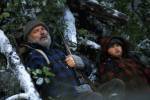


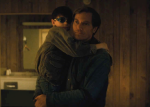







Seek and you shall find: the top 20 films of 2016
It’s easy to lament the decline of mainstream cinema, which this year descended further into predictable franchise fodder. Big budgets and little innovation. The worst comedy of the year (Ghostbusters) was, somewhat ironically, a remake of one of the greatest American comedies of all time. This seems to be the pattern. Hollywood has signalled its intent to continue rehashing old ideas, churning them through the meat grinder, and stripping them of whatever sustenance they had in their original form. Watering down the syrup. Cutting the quality coke with caster sugar. Fresh and exciting stories seem now to only exist on television.
And what a year for television it was: Westworld, The Night Of, Stranger Things and The Night Manager, to name but a few.
But there are those of us that still love the cinematic medium, tragics prepared to actually leave the house to go and see a movie. We spend time trawling releases from year to year, searching for something fresh – a story that takes us momentarily out of our lives, to a place uplifting, devastating, arousing or shocking.
Despite my reservations about mainstream cinema, this is not exactly a list of obscure indie movies. There’s big names here: Tarantino, Iñárritu, Allen, Verhoeven, Favreau and Kaufman. But there’s also a group of consistent smaller directors that seem intent on keeping the dream worlds of movies alive – and are making a name for themselves in the process. Jeff Nichols. Nicolas Winding Refn. Taika Waititi. Damien Chazelle. Park Chan-wook. The fashion designer Tom Ford.
This year’s choice selection is bookended by two female directors – one a Brit who documented youth in America, the other a superb American filmmaker that made not only a tense thriller, but also the best movie of 2016.
Get ready for a movie marathon that won’t disappoint.
[image error]
American Honey
20. AMERICAN HONEY
Director: Andrea Arnold
Release date: November 3, 2016
It’s fascinating that the year’s most incisive movie about modern America was written and directed by a Brit. Acclaimed filmmaker Andrea Arnold used a cast comprised almost entirely of non-actors, save for the impressive Shia LaBeouf and Riley Keough, and travelled across America to immerse herself in the world of “Magazine Crews” – groups of youths who sell magazine subscriptions door-to-door.
In a star-making performance, unknown actress Sasha Lane plays Star, the prism through which we experience this absorbing and stunningly realised journey into America’s heartland. It’s a world of motel rooms, sex, drugs, music and the looming threat of danger is never far away. Star and her band of young salespeople drive through America’s sub-cultures, from the wealthy to the decaying fringes, providing an ultra-realistic depiction of youth against the system. We are shown the American Dream – and it’s rarely pretty.
Arnold may be guilty of pulling some punches – there’s moments that perhaps could have truthfully ventured into darker territory – but American Honey is still one heck of a dizzying experience. Her eye for the minutiae of every key scene adds to the film’s arresting pastiche.
At 163-minutes, this is a lengthy flick, but the movie pulls you into its mesmerising cyclic structure, ultimately presenting us with a moving depiction of a young woman deciding what type of person she wants to be.
[image error]
The Neon Demon
19. THE NEON DEMON
Director: Nicolas Winding Refn
Release date: October 20, 2016
Nicolas Winding Refn refined his cool, detached, all-surface approach in The Neon Demon, a psychological horror movie that feels filtered through the glossy pages of a high-end fashion magazine. Indeed, the 46-year-old Danish director uses the immaculate, superficial visual cues of the fashion world to create a scathing satire. The result is a provocative, impressionistic, sensory experience that stylishly eviscerates the LA fashion scene in a manner as brutal as David Lynch’s searing Hollywood roast, Mulholland Drive..
Elle Fanning is perfectly cast as 16-year-old, small-town doll Jesse, whose descent into degradation seems assured from the first time we see her on camera – posed in a glamorous mock murder scene, covered in blood and make-up. A fashion shoot. Jesse is the embodiment of flawlessness and youth – two commodities the glamorous fashion world worships – and it’s quickly apparent that her fellow models, two played by Aussies Abbey Lee and Bella Heathcote, would like to suck the life from her.
In a side role, Jena Malone steals the show as Ruby, a make-up artist and part-time morgue attendant with a keen eye for beauty. She takes Jesse under her wing. Malone is fearless – and delivers 2016’s most shocking scene.
[image error]
High-Rise
18. HIGH-RISE
Director: Ben Wheatley
Release date: August 18, 2016
J.G. Ballard’s cult classic novel finally made it to the screen this year. It had been a dream project for British producer Jeremy Thomas since the 1970s, and his vision was realised with deliciously retro and kaleidoscopic panache by UK director Ben Wheatley.
Ballard’s exploration of social structure, class tension and the impacts of technology on the human psyche proved entertaining cinematic material, and Wheatley clearly relished the black comedy and violent anarchy of the source novel.
High-Rise follows Dr. Robert Laing (Tom Hiddleston) as he moves into an innovative, self-contained block of apartments. With its own supermarket and recreational outlets, there’s really no need to leave the building, except to step into the real world to hold down a job.
The high-rise was designed by esteemed architect Anthony Royal (Jeremy Irons), a zen-like visionary who, naturally, lives in the lavish apartment that takes up the very top floor. Within the building is a class structure, with poor families able to afford lower apartments and the upper class live closer to the top.
Continued power outages and other technical difficulties see the social structure within the high-rise start to erode, teetering on the brink of chaos.
To enjoy High-Rise you must suspend your sense of common logic and enjoy its sub-text and visual flair. Otherwise you’ll continue to ask why no one simply leaves the building when the inhabitants are gripped by the unfolding chaos. You’re rewarded for this suspension. This is prosaic cinema that remains wickedly funny and wildly absurd. Wheatley offers us a challenging piece of science fiction with a British sensibility, buoyed by a fine cast of actors (Sienna Miller, Luke Evans and Elizabeth Moss included) who clearly relish the pulpy material.
[image error]
De Palma
17. DE PALMA
Director: Noah Baumbach & Jake Paltrow
Released: August 2016
There are those that think that writer-director Brian De Palma is one of American cinemas great living geniuses – and there are those that are wrong. In this loving homage to the great man by devotees and filmmakers Noah Baumbach and Jake Paltrow, the legend himself holds court and takes us through a play by play account of his constantly fascinating career.
There’s no other interview subjects, just a static shot of the fierce visionary in a living room, interspersed with behind-the-scenes clips from his well-known masterpieces, such as Scarface, Carrie and The Untouchables, to his many gems: Blow Out, Phantom of the Paradise, Dressed to Kill, The Fury and Body Double.
For fans and general cinephiles alike, De Palma is a riveting anecdote-heavy journey with an opinionated auteur as its tour guide. A must watch.
[image error]
The Hateful Eight
16. THE HATEFUL EIGHT
Director: Quentin Tarantino
Release date: January 14, 2016
Sure, there are some missteps in what was reverentially branded in its marketing as “The 8th Film by Director Quentin Tarantino“, but even at his most self-indulgent and heavy handed the master filmmaker’s work still towered over much of what mainstream Hollywood had to offer in 2016.
This excessively bloody and murderous tale of eight shady characters trapped in a stagecoach lodge during an aggressive blizzard, set some time after the American civil war, is another provocative showcase for Tarantino’s talents as an auteur. His sharp dialogue and flair for camera and stage direction are writ large, all captured (for those lucky enough to get to the limited screenings) in glorious 70mm Ultra Panavision.
Rich with the actors who’ve become part of Tarantino’s motley tapestry (Samuel L. Jackson, Michael Madsen, Tim Roth, Kurt Russell), The Hateful Eight caused its fair share of controversy amongst the more inane members of the PC establishment. But for more discerning pundits, it was difficult not to jump on the writer-director’s wave-length and enjoy the wild and wordy bloodshed, all set against an Academy Award-winning soundtrack by the great Ennio Morricone.
It’s not Tarantino’s finest work, and contains a very unnecessary voiceover by the man himself, but The Hateful Eight is still devilish fun.
[image error]
David Brent: Life on the Road
15. DAVID BRENT: LIFE ON THE ROAD
Director: Ricky Gervais
Release date: August 25, 2016
Ricky Gervais’ forays into filmmaking in the absence of his writing partner and creative sounding board Stephen Merchant have been problematic, to say the least. Ghost Town, The Invention of Lying and the woeful Netflix outing Special Correspondents have all failed to find the emotional depth – and, indeed, darkness – of The Office, Extras and Cemetery Junction. Clearly, Merchant’s involvement is vital.
It was reasonable, then, that fans of Gervais be forgiven for keeping low expectations about the comedian’s return as the character that made him a household name, the tragic and cheeky loser David Brent. In fact, all of the main players from The Office were noticeably absent from the production of Life on the Road, which gave us something of an ominous feeling.
But, in spite of these concerns, Life on the Road was a welcome surprise. It seems that in Brent – who is no doubt an unfiltered, brutally honest depiction of the comedian himself – Gervais inherently knows what works, and the movie feels like a natural continuation of the character, recapturing the tone of the classic series from whence it came.
In 2016, Brent still dreams of being something – ideally a famous musician – and the pain and palpable melancholy of the character imbue Life on the Road with as many poignant moments as there are laugh-out-loud set pieces. Gervais might ham up a few elements – like the horrible treatment that Brent suffers at the hands of his bandmates – but ultimately Life on the Road is both moving and very funny.
A wonderful return to form for the beloved comic.
[image error]
One More Time With Feeling
14. ONE MORE TIME WITH FEELING
Director: Andrew Dominik
Release date: September 8, 2016
Following the tragic death of his son in July 2015, revered songwriter and lyricist Nick Cave invited filmmaker and collaborator Andrew Dominik to chart the making of his 16th studio record, Skeleton Tree. Captured almost entirely in eerie, sombre black and white, One More Time With Feeling is not just an insight into Cave and his band The Bad Seeds’ creative process, but also a painfully intimate document of this traumatic upheaval that Cave found himself in.
The film is as uncomfortably personal as one might expect, especially if you’re aware of Cave and his family’s loss before viewing. But through that intimacy the film grows into a broader exploration of death and creation, as Cave ruminates on whether such crippling pain really is conducive to the making of art. The songwriter is numbed by his son’s passing, yet finds a way to craft what is perhaps his greatest musical achievement.
[image error]
Café Society
13. CAFÉ SOCIETY
Director: Woody Allen
Release date: September 1, 2016
It seems that in Jesse Eisenberg, prolific writer-director Woody Allen has found the perfect avatar, a vessel through which his trademark bumbling protagonist can be reimagined into youth. Indeed, Eisenberg is a perfect fit for Allen’s witty, verbose style of comedy and he shines in this return to form by the legendary filmmaker.
As much a satire on old Hollywood as it is a love letter, Café Society sees Eisenberg – who previously appeared in Allen’s To Rome with Love – as impressionable Bobby Dorfman, the youngest of a Jewish family living in New York City in the 1930s. Bored of working with his jeweller father, Bobby sets off to Hollywood to work for his uncle Phil (Steve Carrell), a powerful talent agent that brushes shoulders with bona fide screen legends. Phil asks his secretary Vonnie (Kristen Stewart) to show him around the town and the two form an attraction.
In the past six years or so, Allen seems to have gotten his groove back, with the relatively recent Midnight in Paris and Blue Jasmine amongst his better offerings since his purple patch in the latter half of the 1970s. His latest film is aided by Eisenberg and Stewart’s established screen chemistry, with the two previously playing lovers in Adventureland (2009) and American Ultra (2015). But all the cast is excellent, with Carrell at his best and a radiant Blake Lively adding glamour to proceedings. A funny side plot features Corey Stoll as Bobby’s gangster brother.
Café Society leaves you with a sense of melancholy, perhaps reflective of Allen’s longing for this distant golden era of cinematic history.
[image error]
Author: The JT LeRoy
12. AUTHOR: THE JT LEROY STORY
Director: Jeff Feuerzeig
Release date: November 2, 2016
One of the stranger pop-culture stories in recent times was that of Jeremiah “Terminator” LeRoy, a 16-year-old transgender drug addict prostitute author that took the literary world – and Hollywood – by storm in the late ’90s. In one of literature’s most fascinating modern scandals, JT LeRoy, darling of the film and literature universe, turned out to be a fake, a persona created by American writer Laura Albert.
This was no simple nom de plume. Albert pretended to be a 16-year-old over the phone, convincing a psychologist, numerous editors, publishers, journalists and major celebrities, and then followed the ruse to the next logical step – engaging her young sister-in-law to pretend to be JT LeRoy at public appearances. Albert herself became “Speedy” a mysterious British woman who was JT’s manager and confidant.
Needless to say, there was much egg on numerous important faces when the truth was eventually exposed. In Author, Albert gives a candid and (seemingly) honest account of how the JT LeRoy hoax snowballed and evolved, and invites us into the childhood events that may have led to her bizarre controversy. This is a warts-and-all insight into this stranger-than-fiction tale and is full of actual phone conversations with major celebrities that Albert recorded and archived. Feuerzeig does a fine job of depicting this odd chain of events and presents Albert as both an endearing and duplicitous eccentric.
[image error]
Hunt for the Wilderpeople
11. HUNT FOR THE WILDERPEOPLE
Director: Taika Waititi
Release date: May 26, 2016
Taika Waititi had been one of New Zealand’s quiet achievers, writing and directing a string of immensely funny indie flicks (Eagle vs Shark, Boy, What We Do in the Shadows) off the back of his Academy Award-nominated short film Two Cars, One Night. This year’s Hunt For the Wilderpeople cemented Waititi as a fine creator of poignant humanist comedies, no doubt a large reason why the reins of the upcoming Marvel franchise instalment Thor: Ragnarok were dutifully handed to him.
The adventure comedy Hunt for the Wilderpeople was a break-out success in America – and rightfully so. It’s a very funny film, loosely in the “coming-of-age” genre, that tells the story of Ricky Baker (a very natural Julian Dennison), a young teenager who has been bounced around in the foster system. He’s no monster, yet has been cheeky enough to be branded a lost hope. On his last chance, Ricky is sent to a farm with a new set of foster parents. There he is looked after by a very kind “aunty” (Rima Te Wiata) and “uncle” Hec (a grizzled Sam Neill).
A series of unfortunate events lead to Ricky and Hec becoming outlaws, on the run in the New Zealand wilderness. Though Hec was never keen on the idea of taking in a foster child, their predicament ultimately endears young Ricky to the grumpy farmer and they engage in an often hilarious run from the long, bumbling arm of the law.
Hunt for the Wilderpeople was perhaps 2016’s most genuinely funny and heart-warming comedy, rife with memorable and laugh-out-loud moments. It was yet another gem from Waititi, with two fine performances at its centre.
[image error]
La La Land
10. LA LA LAND
Director: Damien Chazelle
Release date: December 26, 2016
When hot and tired motorists trapped on the offramp of the LA freeway break into song, the opening scene of 31-year-old director Damien Chazelle’s latest flick is immediately jarring. Why? Because original live-action movie musicals have almost become a thing of the past. Indeed, La La Land itself feels like a strange set of anachronisms – modern technology littered through the tale of a bygone era. A seamless marriage of old and new.
The opening song-and-dance number on the crowded offramp, ‘Another Day of Sun’, that opens this wonderful movie, demands an adjustment from the viewer – the promise that you’re about to encounter something more than a two-hour episode of Glee.
Once you’ve settled into the rhythm and tone of La La Land, where characters do indeed break into song throughout, you’re richly rewarded by this heartfelt tribute to Los Angeles (LA LA Land, get it?) and to the wide-eyed dreamers that venture there in search of fame.
There’s no doubt that much of the movie’s charm is derived from two immensely talented leads. This is the third time Ryan Gosling and Emma Stone have played on-screen lovers, and their natural chemistry is palpable. Gosling has never been more charming or funny. In La La Land he and Stone play Sebastian and Mia. The former is a jazz pianist who dreams of opening his own club and keeping the dying genre alive. The latter is an aspiring actress, who serves coffee at a cafe on the Warner Bros lot and spends her days between fruitless auditions. Their paths cross and they fall in love.
La La Land is an excellent modern musical, with some genuinely catchy compositions that punctuate key moments. There’s some breath-taking long takes and scintillating camera work, with Chazelle demonstrating a keen eye for set pieces and choreography. The story, of course, is filtered through a romantic, old-Hollywood nostalgia and draws on the visual and sonic language of movie musicals to tell the story of these two lovers in search of their respective dreams. In this way, La La Land‘s themes are comparable to Chazelle’s previous film, the very impressive Whiplash – an exploration of the personal sacrifices required to step out from the crowd. La La Land is likely to be a monstrous success and is, perhaps, a modern classic.
[image error]
The Jungle Book
09. THE JUNGLE BOOK
Director: Jon Favreau
Release date: April 7, 2016
Most remakes are pointless. But this year Jon Favreau created an exception to the rule. Rudyard Kipling’s classic book of short stories has been brought to the screen on multiple occasions by Disney, most notably as the 1967 animation and again in 1994 as a live-action film featuring Jason Scott Lee as an adult Mowgli.
But in 2016, Disney had special effects at its disposal that allowed a live-action child actor to interact and converse with extremely life-like talking animals. Favreau made the most of this technology, directing a stunning visual feast that’s alive with creatures and edge-of-your-seat set pieces.
The Jungle Book nods specifically to Disney’s animated movie, and seamlessly works in some of those classic songs. The presence of Bill Murray, Idris Elba and Christopher Walken in key voice roles is nothing short of sublime casting.
The Jungle Book represents the best that cinema can be – pure, unadulterated escapism.
[image error]
Midnight Special
08. MIDNIGHT SPECIAL
Director: Jeff Nichols
Release date: May 19, 2016
Much was made of The Duffer Brothers’ Netflix nostalgia-fest Stranger Things – and the praise heaped upon that TV series was certainly justified. But it should not be at the expense of Jeff Nichols’ impressive Midnight Special, a tense and beautifully made piece of old-school science fiction.
Just like Stranger Things, Midnight Special owes a lot to the suspense fantasies of the late ’70s and ’80s, from King to Carpenter and, of course, Spielberg. It’s a realistic road movie spliced with fantasy DNA, the fast-paced narrative rocketing to a memorable finale.
The film follows stoic father Roy (Nichols’ go-to actor Michael Shannon) and his son Alton Meyer, a boy with special powers. Roy was a member of a Texas cult built around his son’s incredible abilities, but steals him away in the night. Soon, both the cult’s heavies and members of the American government are after Roy and Alton. Father and son are assisted in their escape by Lucas (Joel Edgerton), a believer in Alton’s power, and Sarah (Kirsten Dunst), Alton’s biological mother. Sam Shepherd appears as the suitably unsettling cult leader and Adam Driver is again impressive as a specialist FBI agent.
The key to Midnight Special‘s success is that Nichols bravely takes this high-concept science fiction seriously and grounds it in gritty realism. As with all classic sci-fi, a suspension of disbelief is required, but the movie richly rewards those that take the journey.
[image error]
Green Room
07. GREEN ROOM
Director: Jeremy Saulnier
Release date: May 12, 2016
This year American writer-director Jeremy Saulnier followed the success of 2013’s critically acclaimed crowd-funded revenge flick Blue Ruin, with the dark and thrilling grindhouse throwback Green Room. It also featured one of the final performances by the talented Anton Yelchin.
This gritty and uber-violent tale follows the plight of young punk band the Ain’t Rights. They’re on a tour that isn’t going so well. They’re low on cash and willing to play anywhere. So much so that they take a dubious last-minute gig at a private party on a property outside Portland. When they arrive, the band find themselves in a full-blown Neo-Nazi compound. They’re part of the musical line-up for a skinhead piss-up.
When the band accidentally witnesses the aftermath of a violent murder, the Nazis panic and lock them in the green room. Leader of the skinheads, Darcy Banker (played with cold cruelty by Patrick Stewart), pragmatically decides that the easiest way to cover-up the crime is to murder the band. What follows is a particularly grim showdown, depicted with bloody flair and relentless realism.
Touring punk bands might find this situation all too real and all too plausible. If you’re prepared to flinch and wince in pain, then there’s a lot to be enjoyed about this impressive, nasty, funny uber-violent gorefest.
[image error]
The Handmaiden
06. THE HANDMAIDEN
Director: Park Chan-wook
Release date: November 3, 2016
After a very brief foray into English language films with 2013’s moody thriller Stoker and a role as producer on the impressive dystopian sci-fi Snowpiercer (released the same year), South Korean filmmaker Park Chan-wook returned to his homeland for the sumptuous, romantic and decidedly erotic thriller The Handmaiden.
The Handmaiden tells an engrossing tale set in Japanese-occupied Korea, early in the 20th Century. Sook-hee (Kim Tae-ri) is a young pickpocket enlisted in a plot by conman Count Fujiwara (Ha Jung-woo) who plans to marry and defraud the mysterious and beautiful heiress Lady Hideko (Kim Min-hee). Count Fujiwara promises to pay Sook-hee a nice cut of the proceeds if she becomes Lady Hideko’s personal handmaiden and helps him in his deception. But they have to act quickly, as their victim lives under the watchful eye of her maniacal and perverse Uncle Kouzuki, a collector of erotic literature and art. He plans to marry his niece and get his hands on the fortune himself. Sook-hee becomes Lady Hideko’s handmaiden but soon finds herself falling in love with her intended victim.
Featuring all the luscious sets and costuming that one might hope for from the period, The Handmaiden effectively transplants the novel Fingersmith by Welsh writer Sarah Waters, set in Victorian era Britain, into gorgeous Korean and Japanese locales. Park Chan-wook, known more widely as the director and co-writer of 2003’s Oldboy, imbues the winding story with romanticism, humour, moments of violence and an especially passionate sex scene.
The Handmaiden is an intoxicating experience.
[image error]
Nocturnal Animals
05. NOCTURNAL ANIMALS
Director: Tom Ford
Release date: November 11, 2016
Fashion designer Tom Ford’s second foray into feature filmmaking opens with skin – a large, naked woman hypnotically jumping up and down in slow motion – and then proceeds to burrow deeper into the subconscious.
A story within a story, Nocturnal Animals finds the prolific Amy Adams as Susan Morrow, a Los Angeles art gallery owner adrift in a period of existential dissonance – she’s questioning her career, lives in a soulless, austere mansion and is in a loveless marriage with Hutton (Armie Hammer). When the manuscript for the debut novel by her estranged ex-husband Edward (Jake Gyllenhaal), arrives, Susan uses her incessant insomnia to stay up on a series of nights and immerse herself in the book.
Susan is shocked by the novel – titled Nocturnal Animals – which is a cold and violent tale of rape, murder and revenge. Through the book’s brutality, Susan is forced to come to terms with the pain she inflicted on Edward through their break-up. The novel’s narrative plays out as Susan reads it alone in her bed.
Tom Ford’s film packs a series of double punches, as the “real” and “fictional” stories unfold, one a pulpy noir, the other a domestic psychological thriller. The novel within the film is played out with shocking realism, its cast including Gyllenhaal, the always brilliant Michael Shannon and Isla Fisher. Aaron Taylor-Johnson plays the novel’s chief antagonist and has never been better – this evil performance might win him an Oscar nomination.
With two stories intertwined, the onus is on Ford to deliver two impressive endings and the source material doesn’t let him or the audience down. Nocturnal Animals is bleak but not distancing. It’s filled with a mesmerising and intensely cinematic atmosphere. Ford’s screenplay, based on the novel Tony and Susan by Austin Wright, is ultimately a rumination on the craft of writing, how an author’s real pain is filtered and mutated before it bleeds on to the page.
[image error]
Elle
04. ELLE
Director: Paul Verhoeven
Release date: October 27, 2016
In another year of decidedly bland mainstream cinematic output, the return of Dutch director and master provocateur Paul Verhoeven, after a 10-year absence, could not have come any sooner. He brought us Elle, a dark, brilliant and decidedly twisted black comedy that the millennial snowflake generation was sure to find a tough morsel to swallow.
Elle begins in the most confronting of ways. Our protagonist Michele, played by Isabelle Huppert at the height of her powers, is being raped. The horrific sounds of the attack are played out on the face of her cat, which coldly watches on. Then we see her attacker, a man dressed in black, wearing a face mask, calmly remove himself from Michele and leave.
It’s Michele’s response to this most brutal of assaults that makes Verhoeven’s first film since 2006’s Black Book, such an endlessly fascinating and challenging movie. Following her assault, Michele cleans her house, bathes, gets an STD check from her doctor and then does not report the rape to the police. The reasons for this become clear later on.
But what is also evident is that Michele has no intention of allowing the attack to disrupt the carefully controlled chaos of her busy and successful life. Michele and her friend Anna (Anne Consigny) run a video game development company, whose specialty is particularly sexual and violent fantasy titles. Michele navigates her relationships with men, an ex-husband, a lover and a son, with coldly precise aplomb. Michele has no room in her life to be a victim.
Verhoeven, now 78, initially wanted to shoot Elle in Boston, with a host of major actresses attached, from Nicole Kidman to Sharon Stone, Diane Lane and Marion Cotillard, but then decided to move the production to France. He learned French to communicate with the cast and crew, perhaps because he knew a US studio might prevent him from depicting this character and story in such an unflinching manner. It appears the decision was a correct one.
Huppert delivered the best performance by any actress in 2016 and was subsequently nominated for a Golden Globe. If there remains discerning voters in the Academy, then we should see her nominated for an Oscar too. Elle is France’s entry in the Best Foreign Language Film category – and it surely deserves to win. A riveting melodrama.
[image error]
Anomalisa
03. ANOMALISA
Director: Charlie Kaufman & Duke Johnson
Release date: February 4, 2016
For many, a simple word association with “Charlie Kaufman” would conjure a list of superlatives – terms like “visionary” and “genius”. And the gifted cinematic mastermind does his reputation no disservice in the moving and fiercely original Anomalisa.
The first R-rated movie to be nominated for the Academy Award for Best Animated Feature (disappointingly pipped by the pleasant but overrated Pixar flick Inside Out), Anomalisa is fiercely unique, poignant and abstract. At times it’s also uncomfortably intimate.
Using stop-motion puppets created with 3D printing technology, the film follows self-help author Michael Stone as he flies to a conference in Cincinnati. He’s in a state of mid-life spiritual crisis, so numbed that everyone around him literally looks and sounds the same (a device provided by veteran character actor Tom Noonan). But then he meets a shy fan who arouses his senses. Her name is Lisa Hesselman (Jennifer Jason Leigh). The two have an affair in the hotel and, at least momentarily, Michael’s existence is imbued with meaning.
Anomalisa deals with similar ideas to Lost in Translation and Up in the Air but, when channelled through these spookily life-like creations, builds a dream-like malaise that is moving, abstract and tactile.
An astoundingly original movie experience.
[image error]
The Revenant
02. THE REVENANT
Director: Alejandro G. Iñárritu
Release date: January 7, 2016
The comfort of a home cooked meal and a long hot shower was essential after enduring 156 minutes of The Revenant. Writer-director Alejandro G. Iñárritu’s follow-up to the Academy Award-winning Birdman is cinema at its most visceral and immersive, a bleak revenge tale and survivalist epic that weighs the emotional impact of blood, snow and dirt above dialogue and characterisation.
The premise is simple. It’s 1823 and Hugh Glass (Leonardo DiCaprio) is guide to a military sanctioned hunting party who are traipsing through the cold wilderness of the Louisiana Purchase to fill their quota of pelts. Minutes into the film the group are ambushed by the Arikara native tribe and in a stunningly realised sequence, in which you’re inclined to duck your head as arrows fly at the camera, a small number of hunters escape. The remainder are slaughtered. It’s a bloody and brilliant set piece.
Soon after, Glass is brutally mauled by a ferocious mother grizzly bear, a feat in movie magic. Slashed and bloody, Glass is discovered on the brink of death and, after attempting to carry him on the stretcher, the hunting party makes the tough decision to leave Glass behind. His son, a half-Pawnee native called Hawk, refuses to leave his father’s side. Another of the party, John Fitzgerald (Tom Hardy) is offered money to stay and make sure Glass is allowed to shuffle off this mortal coil in peace and relative comfort. But Fitzgerald grows impatient and decides to expedite the process. In a brief struggle, Hardy’s character kills Hawk and leaves Glass behind. This proves a mistake.
The themes in The Revenant are suitably simple, but no less profound. In the hands of Iñárritu, who knows how to harness the escapist power of cinema, a thin premise becomes something not just brutally humanistic – but almost biblical in scope. The result is a modern classic, a grand achievement of visceral and emotional power.
[image error]
The Invitation
01. THE INVITATION
Director: Karyn Kusama
Release date: May 11, 2016
From the moment our protagonist’s vehicle strikes a coyote and he’s forced to mercifully execute it, Karyn Kusama’s tense LA thriller, The Invitation, is on a simmer, building heat until its scalding conclusion.
The driver, Will (Logan Marshall-Green) and new girlfriend Kira (Emayatzy Corinealdi) are on their way to a dinner party in the Hollywood Hills. The hosts are Will’s ex-wife Eden (Tammy Blanchard) and new husband David (Michiel Huisman, or Daario Naharis for you Game of Thrones nerds). We learn that the death of Will and Eden’s young boy led to their relationship’s demise. It’s quickly apparent that Will still carries an immense amount of pain, but Eden has seemingly freed herself of grief’s burden by spending time with a New-Age spiritual group called The Invitation.
Further revelation of plot would be a disservice to would-be viewers. But know this – Kusama’s low-budget piece of psychological horror is a masterclass in filmmaking. The cast, none of them household names, are note-perfect, serving the script’s nuances and heavy themes.
The Invitation is rife with sleight of hand and misdirection, often deliciously executed, and the torturous pace, while almost unbearable, is ultimately crucial to the film’s success.
Kusama drags us to a final moment that was the most brilliant and terrifying of any film this year – perhaps of the last decade. They say a picture tells a thousand words – The Invitation’s final five seconds say a great deal more.
DISCOVER THE 20 BEST MOVIES OF 2015.


November 6, 2016
Bill Bailey: interview

By Nick Milligan
The view through the restaurant’s glass wall is a pristine sunny postcard: Sydney Harbour Bridge buffers the brilliant blue of both water and sky, ferries bob against their moorings, tourists ebb and flow through Circular Quay and, of course, those iconic bone sails of the Opera House jut upward in all their jagged glory.
This panoramic is all too familiar to the distinctive chap sitting opposite. Bill Bailey is a regular to our shores. The London-based comedian is a true Renaissance Man; a master of high-concept absurdist humour whose meta jokes and classical music training have ensured regular appearances on stage, film and TV. Bailey’s lightning wit made him a favourite on shows Never Mind the Buzzcocks and QI, and stole many a scene in cult sitcoms Black Books and Spaced. Now he’s turning his attention to writing. The wildlife lover has just finished a book on British birds.
Bailey has dropped into Australia for a whirlwind 48-hour media visit, spreading the word about impending tour Larks in Transit, before he’s off to New Zealand. After entertaining the Kiwis he’ll be back here, straight into another long run of Australian performances.
Bailey’s in the middle of a 12-hour day of interviews across print, radio and TV. He was on Triple J this morning. He was on The Project last night.
But, ever the true professional, he’s hanging in there. We’re sitting in Hacienda, the luxe restaurant and bar nestled in the five-star Pullman Quay Grand, sipping lime and sodas. The décor is inspired by Cuba and 1950s Miami and the bar snacks presented to us by a smiling waitress are too exotic to immediately identify.
“It’s like some kind of Indonesian prawn cracker,” remarks Bailey, after an initial taste test.
The cordial comic is staying here at the Quay Grand.
NM: What are the tea and coffee-making facilities like at this hotel?
BB: Very good. You can’t fault them. There’s a kettle and a coffee maker, so all bases are covered.
You’re obviously a regular to Australia – is there anything you look forward to the most about returning here?
Yeah… I mean (gesturing through the glass), this is a cracking view. I like being able to travel around Australia. Obviously I like to see a bit of the countryside and get out of the city. Hopefully I’ll be able to do a bit of that [on this tour]. There’s a couple of new places on the tour this time that I haven’t performed before, the Gold Coast and Geelong.
I’ve been to Newcastle a few times and really enjoyed it. It’s such a huge country and I’ve been coming here for so long but I keep finding out new bits about it every time. I see new bits of wildlife. Last time I managed to knock off a thing on my list of life things to do, which was dive the Barrier Reef. I also went bird watching at a sewerage farm in Melbourne.
Sydney’s great, I live in London so I feel at home in cities. But Australia, for me, is a unique landscape, which I try and explore if I can. There’s nothing like this really, for a European, there’s no huge open spaces. There’s no deserts, there’s no areas where there’s hardly any people. It’s such an overcrowded continent. So the opportunity to [explore], if I get that, I take it. Because that’s, to me, the real Australia. It’s this vast country. All kinds of different topography, landscapes and incredible wildlife.
It just makes me think [Trump’s] this very lonely, odd, strange character that’s trying on a persona. It’s a fascinating performance piece, from an objective level. On a real level it’s terrifying.”
I wanted to ask you about the process of putting together a show. Do you return home after a global tour like this with a blank slate? Or does the material bleed into the next show from tour to tour?
The shows just morph into each other. I was doing this show two years ago, Limboland, and I then took it into the West End in London. I had a residency there for a while. During that time the show just transformed into something else. Stories came in, new things went out. New music came in, music came out. Gradually the show changed into something else, which formed the basis of what this [new] show is. Completely new ideas, shows, things that have occurred to me over the last year and a half. Plus a lot of [Larks in Transit] is very new. Things that I’ve hardly performed. So it’s a bit of an experiment this show. It’s a bit different from other shows. Trying out stories and trying to reconnect them – to have a sort of narrative thread. So it’s going to take shape over the next few weeks.
And the show contains some anecdotes too? Stories from the road?
Sure, yeah. A bit of that. That was a jumping off point. That seemed to be a good starting point and it leads into lots of other stories. It’s a way into lots of different subjects.
So if you were to put the first and last show of your tour side by side, they’d look very different?
Yeah. When you’re putting it together there’s a vague structure, but within that I like to keep it fairly loose. There’s a lot of audience involvement in this show. People have to turn up and sing.
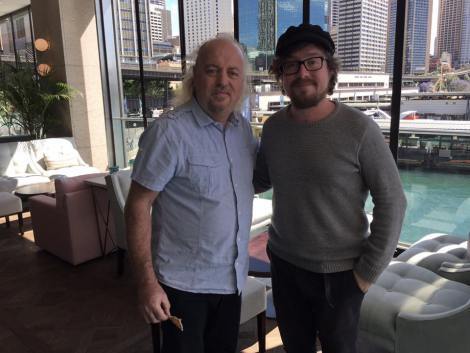
Bill Bailey, with “Indonesian prawn cracker”, and myself at Hacienda, Quay Grand, Sydney.
When you’re putting a show together, where are you the most productive? Do you have a space at home?
Yeah, I have a little office at the bottom of the garden and I go and work in that. But I work everywhere. Everywhere you get the opportunity. If I’m out and about, I’ll write notes down on my phone. Or I’ll record something. If I think up an idea I’ll try and record it before I forget. There’s a writing period and then there’s a sort of cogitative period where you think about it and how it might fit together. Often the only way to really get it to work is to say it out loud. Often you’ll say something and then you transfer that to speech and it doesn’t quite flow. You have to paraphrase what you’ve written to make it sound more coherent. It seems awkward when you say these lines and you only get to know it when you say it in front of a crowd.
So you’re roadtesting material on the audience?
Totally. A lot of the time I write material on stage, in the moment.
Are there jokes that, on paper, should work but they just don’t?
Yeah. Sure. It’s such an odd thing, comedy. It’s so perverse. It doesn’t follow any rules. Things that don’t seem to work on paper come alive when you say them live. Similarly, you think ‘Oh, this is a great joke, I’ll say this…’ and it comes out and it doesn’t translate. It’s weird. It’s why I find [comedy] so fascinating, it’s still a mystery.
Because these are metal heads. If they don’t like you… I had these visions of me being thrown into a moshpit and devoured.”
Music’s always been a big part of your stand-up shows. Has the way you use music in your shows evolved a lot since the beginning? And has new technology been a part of that evolution?
Yeah, definitely. In fact there’s something in this show that I’ve been wanting to do for years. I was hampered by the technology, and that was to sample live an audience singing. I tried it years ago but it was really primitive compared to today’s technology. It was a floppy disk, it was so slow and there was no memory space. But now with digital sampling I can finally do this thing I’ve wanted to do. It doesn’t change that much. The keyboards, I like to keep them fairly low-tech. If they get too high-tech there’s too much going on. I used a keyboard once at a show that had a touch screen and, in the moment, the adrenaline’s pumping and I went to touch – it should have been like an iPhone, where you just gently touch it. But when you’re pumped up, you go like that [makes a sharp pressing motion]. I press and hold and then I’m in a totally different mode. I’m in record mode. I had to sack it.
Natural history and the animal kingdom are often features of your show. Did you develop a love of the natural world as a child?
I grew up in a rural part of the west of England and we were surrounded by countryside. I’d go out on cycling trips as a kid. Mum and dad were very keen on that. We’d go to bird sanctuaries and wildlife reserves as a regular family day out. It’s something that’s stuck with me over the years. It seems like a natural thing to do. I like to know the names of things. My granddad was quite good with plants and birds. I was always really impressed with that. I want to know the countryside. You feel a bit inadequate if you don’t.
You touch on politics in your performances too. With the planet in such a strange place at the moment, perhaps even balancing on the precipice of something terrible, is it harder or easier to find humour in the world?
Honestly, there’s parts of the American election campaign which are beyond satire. There’s no way around it. What is happening is surreal and strange and odd and funny on an objective level. It’s a challenge for a comic. You have to find a way around – to make fun of other things. Pick it apart. Say, for example, Trump’s conversations that were recorded about women. He wanted to grab ‘em and kiss ‘em. He says it’s “locker room talk”. And I just say, this is like no locker room talk I’ve ever heard! I know blokes, I’ve been in locker rooms. They don’t talk about women, grabbin’ them and kissin’ them. They just don’t. Blokes talk about sheds, and cars… and lockers! Shoes, equipment. Blokes are obsessed with stuff. They won’t be going [creepy voice] “Yeah, I got this woman, right…” They just won’t.
It just makes me think [Trump’s] this very lonely, odd, strange character that’s trying on a persona. It’s a fascinating performance piece, from an objective level. On a real level it’s terrifying, the possibilities of him winning. But I also wonder what might happen if he loses. There’s any amount of material. Politics always throws up stories. At the moment it’s overload. There’s too much news, I can’t cope with it.
And Brexit too.
It’s chaos. Total chaos. We’re sailing into fog and we don’t know what the hell we’re doing. Nobody’s got a plan. I’ve never known Britain to be this divided. I’ve never known it to be this theoretically divisive, mobile state. It’s unprecedented.
When you visit Australia you occasionally turn the microscope back on us…
Sometimes, yeah (chuckles).
What’s your outsider’s perspective on Australia at the moment?
Generally, I’ve got to know a little bit about Australian politics. I do follow it, having an interest in the country. Every time I come here there’s a different prime minister. That tells me something (laughs). Something’s gone on. I’m quite envious of that. If you don’t like someone, you just chuck ‘em out! You just throw them out. Unceremoniously dumped. We just can’t do that in Britain. It doesn’t happen like that. You’re stuck with them for five years. So I’m slightly envious of that. There’s a practical sense of… “nope, you’re no good. Out!” I quite like that.
Because of the music in yours shows, you’ve crossed over into playing musical festivals in recent years. Was that a surprise turn in your career?
Not so much, I think comedy has been a presence at festivals for a long time now. There’s always a comedy tent. What was a new development was when I played at Sonisphere a few years ago, which is a metal festival. It’s predominantly metal. I was headlining one of the stages, which was a really nerve-wracking prospect. Because these are metal heads. If they don’t like you… I had these visions of me being thrown into a moshpit and devoured. Nothing would be left. Also, the pressure was on because I had to do a set and it had to be finished on time because after me was Slipknot. I didn’t want to upset the Slipknot fans. It was fantastic fun. It was an absolutely brilliant experience. I’d love to do it again.
You also got to jam with Deep Purple at a fundraiser. What songs did you do?
I got to play ‘Smoke on the Water’… with Deep Purple. It was just one of those things. ‘Oh well, tick that one off.’ They said, ‘don’t just play guitar, that would be too predictable’, so I jammed along with them with the tuned alpine cowbells. I’ve got the cowbells in the [new] show, actually. As a tribute to that. I do the Bells of Rock.
How many instruments do you own?
Do I own? Oh, lord. I don’t know. Probably too many.
Hundreds?
Hundreds. Yeah. Lots of guitars, lots of stringed instruments, lots of traditional, old-fashioned folk things: like mandolas, sitars, mandolins, bouzoukis, banjos, saz, oud. Things like that. I’ve got a lot of keyboards, from way back, old vintage ‘80s synths, Sequential Circuits, Pro Ones, Prophets, all sorts of strange things made of wood. I do collect instruments, yeah.
Do you go looking for them when you’re on tour?
Yeah. In fact I’m often steered away from them by my tour manager, otherwise we’ll end up carting them around and all the way back home.
You’ve achieved so much in your career so far, across stage, TV and film. But is there anything on your creative bucket list that you still need to cross off?
Yes, I would like to write more. I’ve just written a book on British birds. But I’d like to do more writing. I enjoy the process of it. I’d like to collect my thoughts into a book at some stage. I think that would be a good process anyway, it’s a good discipline to do that. I’m in the process of writing a sitcom for the BBC, when I get back [to England]. So that’s the next thing. We’ll see where that goes. More writing, maybe take a break from touring for a couple of years and focus on writing.
You’ve toured consistently for many years.
It’s been solid for a while now. I’m due some R’n’R.
Don’t miss Bill Bailey at Newcastle Entertainment Centre on Monday, December 5. Tickets selling fast through Ticketek.


November 2, 2016
Morrissey: live review
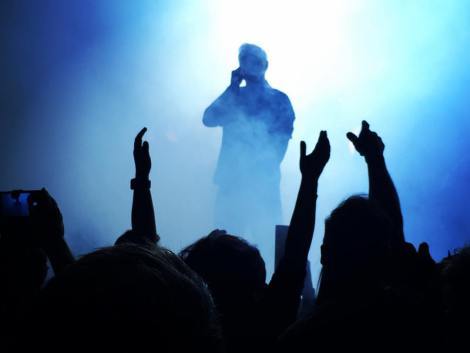
MORRISSEY
Newcastle Civic Theatre
Monday, October 31, 2016
Not many modern artists can claim to induce fainting amongst their audience. Some have tried. Alice Cooper gets his painted craggy noggin lopped off night after night to deafening cheers. Death metal harbours its share of ghouls and depravity. Mainstream American country music is inherently terrifying.
But you best be ready when you’re going to see former Smiths frontman Morrissey. Because you’re going to see something real; hot crimson arcs jetting from the jugular of a freshly slain heifer, broken bones, baby chickens poured into a meat grinder. The flesh production machine in all its glory. It’s the kind of ultra-violent pastiche that temporarily put A Clockwork Orange’s protagonist back on the straight and narrow.
Morrissey is pop music’s evergreen agent provocateur and he’s nothing if not set in his ways.”
Morrissey is pop music’s evergreen agent provocateur and he’s nothing if not set in his ways. A montage of barbaric and uber-graphic animal slaughter commences on a giant screen across the back of the Civic Theatre’s illustrious stage. The song, of course, is ‘Meat is Murder’. A Smiths classic. There’s been no more potent statement made about veganism in popular music. Thirty six years after its release, the once slow and dreamy title track from the band’s 1985 sophomore record is now a venomous, loud, ideological sledgehammer. Morrissey, bathed in vivid red light, points into the shocked crowd as he decries “it is murder!” He then points at the unfolding carnage behind him. A farmer takes a blowtorch to a writhing bull’s horns.
As the intensity of this sensory overload draws to a close, a nearby gentleman faints. This is nothing new. A woman at the previous show, in Wollongong, also fainted. That, of course, is the entire point. Morrissey is confronting 1400 people with unquestionable success. It’s not gleeful. He doesn’t believe in this slaughter. He wants you to be sickened. To bear witness.
This is all part and parcel of a Morrissey show. He seems disinterested, but he’s not. Buried deep inside this God-like, velvet-voiced misanthrope is gratefulness for his legion of fanatical worshippers, but you can be sure as hell that Morrissey is not about to pander or seek cheap adoration. Audience screams of “I love you” come perilously close to provoking a smile, but are met instead with an expression somewhere between discomfort and pity.
His fans try to embrace him. Hold him. They’re overcome. Hysterical. That’s just what they do.”
It’s not all bad though. Morrissey is present, he’s not about to phone it in. Morrissey has stated that he “doesn’t perform”. What he does is real. Tonight he wanders back and forth across the stage, bestowing those in the front row with warm handshakes. Sometimes punters are unwilling to let go, prompting security to rush from the stage’s wings to unclasp reluctant fans. Then, during ‘Jack the Ripper’, multiple audience members rush the stage, trying to latch on to the crooning idol. Moz calmly pulls away as security guards crash tackle these crazed Mozheads, tossing them back into the crowd like sacks of wheat. Morrissey allows a smile, albeit a wry one, because he was expecting this. His fans try to embrace him. Hold him. They’re overcome. Hysterical. That’s just what they do.
What Newcastle has received tonight is a setlist designed for the hardcore followers, of which there are many. The stalls of the Civic Theatre are full of overseas tourists, the unwavering devotees who literally follow Morrissey around the world and attend every show. They’ve seen him thousands of times. They’ll see him thousands more.
For the fair-weather fans, the set is light on Smiths material. This is perhaps because it’s Morrissey’s third tour in five years – Smiths tracks played a larger part of those previous appearances – and we’re only two hours from Sydney. Across his 2012 and 2015 visits, Morrissey performed six nights in Sydney. He’s covered Smiths territory. So far ‘How Soon is Now?’ has been played at every performance on this Australian visit, but it won’t appear tonight, the final date of the tour. It’s replaced instead with a few tracks from the vault.
The night opens with ‘Suedehead’, that sublime hit single from his 1988 solo debut, Viva Hate. Without his Smiths band mates, Morrissey’s approach is much louder and heavier, void of the romantic wash of his early recordings. The well-dressed live musicians on the Civic’s stage are a powerful stadium rock band. Their sound is gigantic, reflecting the rockier direction of numbers like ‘Irish Blood, English Heart’. That track brings the Civic Theatre to life and a glint in Morrissey’s eye suggests the penny has dropped. In Newcastle’s he’s found a fresh pocket of devotees.
The following number is a rare gem – ‘Because of My Poor Education’, the B-side to the 2009 single ‘I’m Throwing My Arms Around Paris’ (the latter also appears in tonight’s set). It’s the first time ‘Poor Education’ has appeared sung live since 2009. Later another rare track appears, ‘Good Looking Man About Town’, the B-side to his 2006 single ‘You Have Killed Me’. It hasn’t been performed since 2007. Morrissey’s reaching deep into the bag. Though rarities are always welcome, ‘Good Looking Man About Town’ feels like too big a lull after the shock of ‘Meat is Murder’ and a red-hot rendition of another Smiths tune, ‘What She Said’.
Other choice selections include the resplendent ‘The World is Full of Crashing Bores’, in which Morrissey, ever the anti-Monarchist, uses Prince William and Princess Kate as the backdrop. Recent tune ‘Kiss Me a Lot’ has a refreshingly romantic bent, as does the 2004 hit single ‘Let Me Kiss You’.
Animal rights are again front and centre in the playful ‘The Bullfighter Dies’, while ‘All the Lazy Dykes’ proves a less interesting interlude (though it does lead into the aforementioned ‘Meat is Murder’ segment).
Before the 20-song set approaches its encore, Morrissey delivers the inevitable shirt removal. With trademark dramatic flair he rips the silken garment, with its plunging neckline, from his impressive physique and tosses the sweat-laced textile into the front row of the audience. Mozheads fight over the prize like starving dogs over an elusive scrap.
The one-song encore is not what anyone could have expected. Morrissey, ever the tease, doesn’t deliver a Smiths classic. Instead, he offers something out of the box: a spirited cover of The Ramones’ ‘Judy is a Punk’. He smiles at its conclusion, leans into the microphone and states with all sincerity, “I love you.”


October 31, 2016
The Jezabels: live review
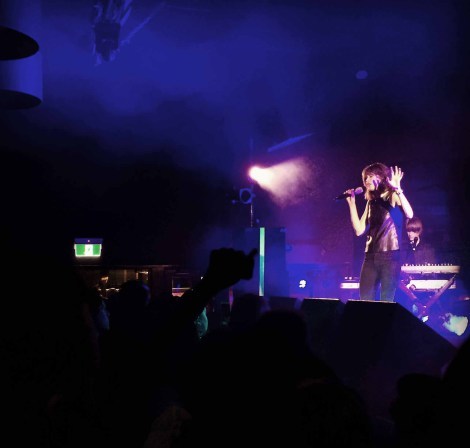
THE JEZABELS
Bar on the Hill
Saturday, October 22, 2016
It’s taken nearly 10 years for The Jezabels’ compositions to catch up with their talents and ambition. They’ve always had the tools at their disposal but their best material seemed elusive. Like Rodin sculpting from sweet potato.
There has, of course, been moments or true brilliance. Flashback to ‘Hurt Me’ in 2009 and you’re struck by the possibility of it being one of the most epic Australian pop songs of all time. ‘Endless Summer’ is in the same ballpark. Their sound exists in a vacuum, detached from genre and influence. No one else sounds like them.
There’s no doubt that what followed was sheer pop efficiency (see ‘Look of Love’), but were there songs that took you by the throat? True believers (such as myself) yearned for justification to keep them on that high pedestal. Their second record was accurately called The Brink.
Thank Christ for Synthia. The Jezabels’ third record elevates them, transforms the four-piece into the stadium act they’ve promised to be. Tonight at the University of Newcastle we’re treated to such a performance, grandiose in both sonic and emotional scope. They now have the songs to take an audience on a journey, to be both wrenching and sublime. In 2016 you can dance and cry at a Jezabels show.
Dressed in black, they emerge amongst billowing smoke and pulsing electronic blips, indicative of their penchant for raw theatricalities. Singer Hayley Mary doesn’t appear until the opening throes of Synthia’s first track, ‘Stand and Deliver’, with its childlike spoken word intro and slow-build to thundering beauty. Then Synthia’s second track, ‘My Love is My Disease’, arrives, a song that three years ago might not have been arranged and propelled with such speed and haunted urgency.
The triad of drummer Nik Kaloper, guitarist Sam Lockwood and keyboardist Heather Shannon (there’s no bass player) conjures immense soundscapes, alive with dynamics that shift from dark to light, always with undeniable beauty. Hayley Mary, every bit the smoldering rock enchantress, moves as if the ghost of Chrissy Amphlett momentarily possesses her – coquettish, irresistible, dangerous. She’ll tongue kiss you then rip your still-beating heart from its chest. But with a cheeky grin or dorky dance, the vocalist returns to human form. The relatable rock chick.
But, fuck, what a voice. Hayley’s acrobatics fill the Bar on the Hill – aching, powerful, fragile, a kaleidoscope of colour. She’s a shining light in Australian music. During gems from the Jezabels’ back catalogue, like ‘Mace Spray’, ‘Disco Biscuit Love’, and new jewel ‘Pleasure Drive’, the vocals are rapturous. Effortless.
‘Come Alive’ is the set’s highlight, as it is Synthia’s. Hayley coos: “Gather round all you young, heed my warning”, and you must obey. The brooding maelstrom rises into a scintillating explosion, leaving the listener to hold on for dear life.
After the slinking, sexy, fuzzy pop of ‘Unnatural’, Hayley jokingly asks the crowd’s English students to apply some meaning to its lyrics. Apparently there is no meaning. I was disappointed to learn it wasn’t written from the point of view of a tub of yoghurt in the midst of an existential crisis. With lyrics like “Through the dessert with mother” and “I’m cloaked in milk” and “One day I’ll make a cream to make the day stay this way” and “and out on the field they ran in glee, did circles out on the field, always been a part of me”, there’s surely no other interpretation.
There’s lots of hit singles to fit into one Jezabels show and they arrive thick and fast after a solid 90-minutes of Synthia-heavy setlist. ‘Hurt Me’, ‘Endless Summer’, new stomper ‘If Ya Want Me’ and seven-minute dreamy slow-burner ‘Stamina’ see us through to the encore.
No one’s ready for bed, so the band offers to keep us up a little longer. They reappear and kick off the encore with a return to their Dark Storm EP in ‘A Little Piece’. Then it’s time for aptly titled closer ‘The End’. It’s a big finale. An anthem penned as only The Jezabels can. To answer the question posed in its chorus (“Is this the end? I want to know…”) – no, this is far from the end. The bar has been raised even higher. And that’s a scary thought.


August 27, 2016
Best movies of 2016 so far
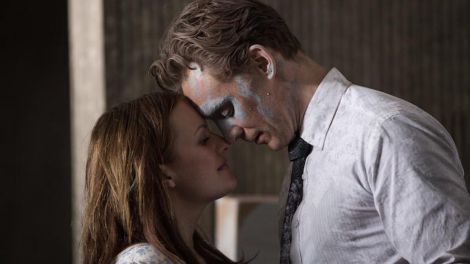
Elizabeth Moss and Tom Hiddleston in High-Rise
While many cinephiles are lamenting the quality of mainstream cinema’s output in recent years, there’s been a number of truly enjoyable flicks to emerge in 2016.
It’s no surprise that the diamonds in the rough are mostly low-budget auteurist gems, as mainstream Hollywood continues to dance with sequel fatigue and pointless reboots.
The films mentioned below are by directors who still carry the torch for quality cinema – and this year they’ve given us movie geeks some hope for the future.
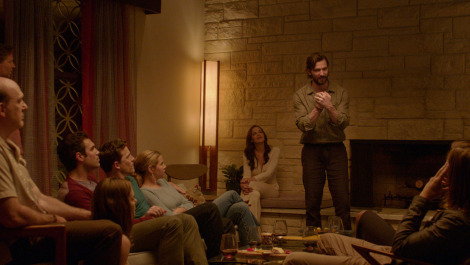
The Invitation
THE INVITATION
Director: Karyn Kusama
From the moment our protagonist’s vehicle strikes a coyote and he’s forced to mercifully execute it, Karyn Kusama’s tense LA thriller, The Invitation, starts to simmer, building heat until its scalding conclusion.
The driver, Will (Logan Marshall-Green) and new girlfriend Kira (Emayatzy Corinealdi) are on their way to a dinner party in the Hollywood Hills. The hosts are Will’s ex-wife Eden (Tammy Blanchard) and new husband David (Michiel Huisman, or Daario Naharis for you Game of Thrones nerds). We learn that the death of Will and Eden’s young boy led to their relationship’s demise. It’s quickly apparent that Will still carries an immense amount of pain, but Eden has seemingly freed herself of grief’s burden by spending time with a New-Age spiritual group called The Invitation.
Further revelation of plot would be a disservice to would-be viewers. But know this – Kusama’s low-budget piece of psychological horror is a masterclass in filmmaking. The cast, none of them household names, is flawless, serving the script’s nuances and heavy themes. The film is rife with sleight of hand and misdirection, often deliciously executed, and the torturous pace, while almost unbearable, is ultimately crucial to the film’s success.
Kusama brings us to a final moment that might be the most brilliant and terrifying of any film since the 1970s. They say a picture tells a thousand words – The Invitation‘s final five seconds say a great deal more.
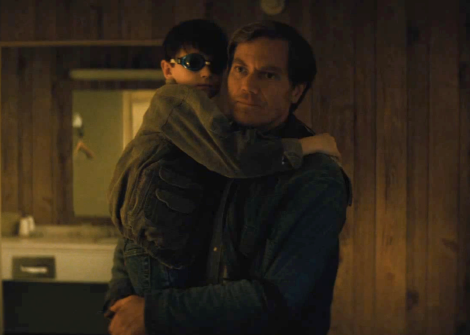
The Midnight Special
MIDNIGHT SPECIAL
Director: Jeff Nichols
Much has been made of The Duffer Brothers’ Netflix nostalgia-fest Stranger Things – and the praise heaped upon that TV series is entirely justified. But it should not be at the expense of Jeff Nichols’ impressive Midnight Special, a tense and beautifully made piece of modern science fiction.
Just like Stranger Things, Midnight Special owes a lot of the suspense fantasies of the late ’70s and ’80s, from King to Carpenter and, of course, Spielberg. It’s a realistic road movie spliced with fantasy DNA, the fast-paced narrative rocketing to a memorable finale.
The film follows stoic father Roy (Nichols’ go-to lead Michael Shannon) and his son Alton Meyer, a boy with special powers. Roy was a member of a cult built around his son’s abilities, but he flees with him in the night. This leads to a chase from both the cult’s heavies and the American government.
The cast, which includes Joel Edgerton, Kirsten Dunst, Adam Driver and Sam Shepherd, use their immense skills to elevate Midnight Special above its potentially silly premise. More importantly, Nichols is game enough to take this subject matter seriously – and he pulls it off with undeniable effectiveness.
The future of genre films is safe in the hands of filmmakers like Nichols.
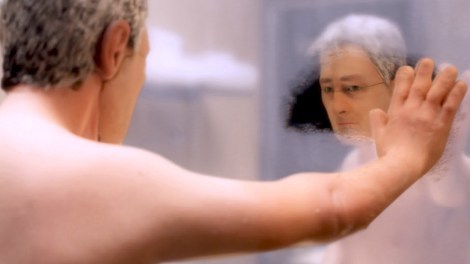
Anomalisa
ANOMALISA
Directors: Charlie Kaufman and Duke Johnson
For many, a simple word association with “Charlie Kaufman” would conjure a list of superlatives – terms like “visionary” and “genius”. And the gifted cinematic mastermind does his reputation no disservice in the moving and fiercely original Anomalisa.
The first R-rated movie to be nominated for the Academy Award for Best Animated Feature (disappointingly pipped by the pleasant but overrated Pixar flick Inside Out), Anomalisa is fiercely unique, poignant and abstract. At times it’s also uncomfortably intimate, both literally and emotionally.
Using stop-motion puppets created with 3D printing technology, the film follows self-help author Michael Stone as he flies to a conference in Cincinnati. He’s in a state of internal crisis, adrift in existential melancholy, so numbed that everyone around him looks and sounds the same (a figurative device provided by veteran character actor Tom Noonan). But then he meets a shy fan who arouses his senses. Her name is Lisa Hesselman (Jennifer Jason Leigh). The two have an affair in the hotel and, at least momentarily, Michael’s existence is imbued with meaning.
Anomalisa deals with similar ideas to Lost in Translation and Up in the Air but, when channelled through these spookily life-like creations, creates a dream-like malaise that is moving, abstract and tactile. A successful cinematic experiment.

Green Room
GREEN ROOM
Director: Jeremy Saulnier
American writer-director Jeremy Saulnier follows the success of 2013’s critically acclaimed crowd-funded revenge flick Blue Ruin, with dark and thrilling grindhouse throwback Green Room. It also features one of the final performances by the talented Anton Yelchin.
This gritty and uber-violent tale follows the plight of young punk band the Ain’t Rights. They’re on a tour that isn’t going so well. They’re low on cash and willing to play anywhere. So much so that they take a dubious last-minute gig at a private party on a property outside Portland. When they arrive, the band find themselves in a full-blown Neo-Nazi compound. They’re part of the musical line-up for a skinhead piss-up.
When the band accidentally witness the aftermath of a violent murder, the Nazis panic and lock them in the green room. Head of the skinheads, Darcy Banker (played with cold cruelty by Patrick Stewart), pragmatically decides that the easiest way to cover-up the crime is to murder the band. What follows is a particularly grim showdown, depicted with bloody flair and relentless realism.
Touring punk bands might find this situation all too real and all too plausible. If you’re prepared to flinch, then there’s a lot to be enjoyed about this impressive horror movie.
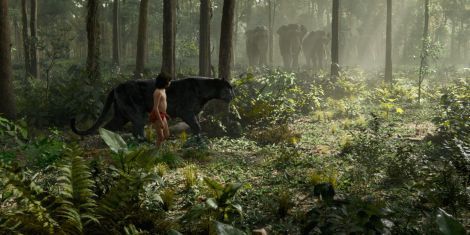
The Jungle Book
THE JUNGLE BOOK
Director: Jon Favreau
Most remakes are pointless. But this year Jon Favreau created an exception to the rule. Rudyard Kipling’s classic book of short stories has been brought to the screen on multiple occasions by Disney, most notably as the 1967 animation and again in 1994 as a live-action film featuring Jason Scott Lee as an adult Mowgli.
But now, in 2016, Disney has special effects at its disposal that allow a live-action child actor to interact and converse with extremely life-like talking animals. Favreau makes the most of this technology, directing a stunning visual feast that’s alive with creatures and edge-of-your-seat set pieces.
The Jungle Book nods specifically to Disney’s animated movie, and seamlessly works in some of those classic songs. The presence of Bill Murray, Idris Elba and Christopher Walken in key voice roles proves sublime pieces of casting.
The Jungle Book represents the best that cinema can be – pure, unadulterated escapism.
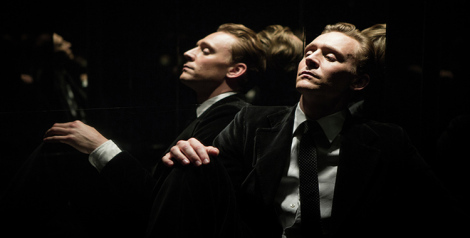
High-Rise
HIGH-RISE
Director: Ben Wheatley
J.G. Ballard’s cult classic novel finally makes it to the screen. It had been a dream project of British producer Jeremy Thomas since the 1970s, and here his vision is realised with deliciously retro and kaleidoscopic panache by UK director Ben Wheatley.
Ballard’s exploration of social structure, class tension and the impacts of technology on the human psyche is clearly not an easy narrative to depict on screen, but Wheatley relishes the black comedy and violent anarchy of the source material.
High-Rise follows Dr. Robert Laing (Tom Hiddleston) as he moves into an innovative, self-contained block of apartments. With its own supermarket and recreational outlets, there’s really no need to leave the apartment except to step into the real world to hold down a job.
The building was designed by esteemed architect Anthony Royal (Jeremy Irons), a zen-like visionary who, naturally, lives in the lavish apartment that takes up the very top floor. Within the building is a class structure, with poor families able to afford lower apartments and the upper class closer to the top.
Continued power outages and other technical difficulties see the social structure within the high-rise start to erode, teetering on the brink of chaos.
To enjoy High-Rise you must suspend your sense of common logic and enjoy its sub-text and visual flair. Otherwise you’ll continue to ask why no one simply leaves the building when the inhabitants are gripped by the unfolding chaos. You’re rewarded for this suspension. This is prosaic cinema that remains wickedly funny and wildly absurd. Wheatley offers us a challenging piece of science fiction with a British sensibility, buoyed by a fine cast of actors who clearly relish the juicy material.
Also see: THE REVENANT: review


July 6, 2016
Best albums of 2016 so far
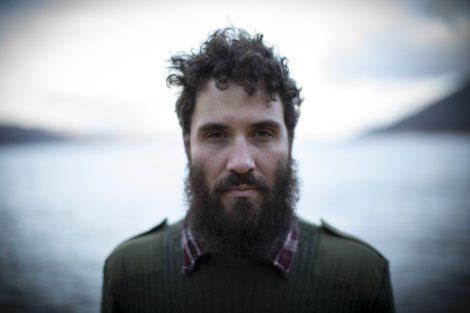
William Crighton
At the halfway point of 2016, the music world has been rejoicing and mourning in equal measure. It’s been one of the best years for new music in a decade, yet the achievements of the world’s songwriters stand in the long shadow cast by a series of departed superstars. Giants like David Bowie, Merle Haggard and Prince have stepped into the wings after their final encore.
As we remember the contributions of those legends, let’s also indulge in some ripe new produce. Here are some of the best records of 2016 so far.
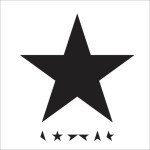 DAVID BOWIE
DAVID BOWIEBlackstar
David Bowie’s final studio record became a theatrical magic trick worthy of Labyrinth‘s Goblin King. Upon his death, which caused widespread devastation, the themes embedded in the envelope-pushing Blackstar took on new meaning. Viewed through the prism of a man aware of his impending departure, the album is the trailblazing legend’s final musical statement – as stunning, esoteric and deliciously brazen as Bowie’s fans could have hoped for. Now we wait for the inevitable swathe of unreleased material.
 THE DRONES
THE DRONESFeelin Kinda Good
When The Drones release a new album, it’s best to expect the unexpected. Feelin Kinda Good delivers on the band’s early promise of not just pushing the sonic envelope, but also gleefully desecrating every modern music convention they can get their greasy paws on. Here, on their seventh record, songwriting mastermind Gareth Liddiard’s acid tongue is as voracious and verbose as ever, twisting around enough subjects to fill a volume of the Funk and Wagnalls. He spits rhymes in compelling rhythms, more rapper than rocker. Bassist Fiona Kitschin’s eerie vocals add beauty, albeit unsettling beauty, to the discordant throbs of keyboards and demented instrumentation. This is The Drones at their most weird and wonderful. They remain Australia’s best band.
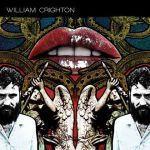 WILLIAM CRIGHTON
WILLIAM CRIGHTONWilliam Crighton
It’s an increasingly rare feeling to break bread with a record that feels legendary – and isn’t 40 years old. But William Crighton’s debut effort is indeed one of those elusive modern classics, a stirring and powerful songbook with literary ambition.
This collection of tunes that spans alt-country, rock, and psych-folk – with poetic flair – taps into Australian culture and then sets its gaze further, as Crighton ruminates on mortality and the broader human experience. The tracks sometimes feature murder and suicide, and then tip to the other end of the emotional spectrum: love and loyalty. William Crighton is sure to prove the most exciting discovery of 2016 for a great many discerning music lovers. Any “best of the year” list void of this album has been compiled by a hack.
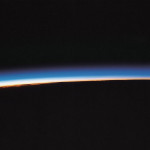 MYSTERY JETS
MYSTERY JETSCurve of the Earth
In 2008, lots of Aussies discovered Twickenham indie-pop group Mystery Jets when their twee duet with Laura Marling, ‘Young Love’, became a hit on Triple J. The tune, while irresistibly catchy, was very much of its time – cute, minimal and… well, cute. But since then the band, led by angel-voiced Blaine Harrison and his dad Henry (who rocks the keyboards), the band have consciously evolved and crafted increasingly nuanced anthems. That metamorphosis has come to a head on Curve of the Earth, a mammoth prog-pop opus that is hypnotising in its beauty. Perhaps the title suggests the band are on the precipice, at inspiration’s peak, wide-eyed at the possibilities of their sound. The rhythm section hums beneath a wall of glorious synthesiser and rock guitar. It’s decidedly British. It’s decidedly brilliant.
 THE JEZABELS
THE JEZABELSSynthia
The Jezabels fell victim to the brilliance of their debut material. The Sydney quartet’s triptych of EPs indicated they were the future of rock music in Australia. Their sound, buoyed by the ethereal vocals of Hayley Mary, was overwhelmingly emotive and felt dislocated from any trend or definable influence. It was of its own universe.
Their inevitable debut record, and its follow-up, contained singularly great tracks (‘Endless Summer’ an undeniable creation) but there was also a sameness across both albums, as if the band had reached a glass ceiling of innovation that they could not quite break through. On Synthia, the group smash the ceiling to smithereens. Dark, mesmerising, unconventional and otherworldly, Synthia feels like a band that has deconstructed its sound and built into something radiant and towering. It’s the journey we’ve been craving. A promise fulfilled.
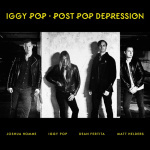 IGGY POP
IGGY POPPost Pop Depression
“Post Pop Depression” is surely what the music world will feel when Iggy snarls and spits his way off the end of this mortal coil. But, in the meantime, we can bask in the twisted machismo of one of the last living punk legends. Pop has long waded through the swamp of man’s nature, and on Post Pop Depression he finds a suitable modern adventurer with whom to frolic. The leathery warlock is front and centre – exactly where he should be – but Queens of the Stone Age captain and Kyuss alumni Josh Homme is behind the screen, orchestrating this dark and masculine theatre. The result is a beautiful fusion of both their sensibilities – Pop’s dulcet delivery and red-blooded poetry dancing with Homme’s cinematic, inventive arrangements and kinky riffage.
 THE BESNARD LAKES
THE BESNARD LAKESA Coliseum Complex Museum
With an album title that should sufficiently tickle prog-rock fans in their giblets, The Besnard Lakes return with their fifth interstellar excursion. A Coliseum Complex Museum doesn’t exactly take the Montreal six-piece boldly where no Besnard album has gone before. But whatever lack of self-imposed invention the album may harbour, ACCM is too shimmering, catchy and radiant to avoid repeated listens. For a band named after a still body of water, their echoey wall-of-sound rises and crashes in glorious waves. High vocals and reverb-drenched guitars hint at alt-country, power pop and prog influences, but the ingredients are melted down into a lysergic kaleidoscope that is unmistakably the work of The Besnard Lakes. Closer ‘Tungsten 4: The Refugee’ is one of the best songs of 2016.
 MELODY POOL
MELODY POOLDeep Dark Savage Heart
It’s shaping up to be Melody Pool’s year. The Kurri Kurri-raised, Melbourne-based songwriter has made a stirring creative statement on Deep Dark Savage Heart, an inspiring and always arresting songbook of strength and sensuality.
Pool’s impressive debut album The Hurting Scene, released three years ago, was forged in the flames of heartbreak. The pain-laced lyrics were those of a young woman not just suffering the loss of someone she loved, but the suffocating sting of betrayal. Cathartic and aching, the album’s centrepiece, ‘Henry’, was a mature and fatalistic distillation of her anger and hurt. But, conversely, The Hurting Scene‘s radiant melodies and arrangements were invariably upbeat, belying the emotional weight within.
Deep Dark Savage Heart is a far different beast. It’s a dark folk record, cast in shadowy minor chords, and a work of staggering beauty. The arrangements and melodies dance and twirl beneath the moonlight in a synergic embrace.
Full review here.
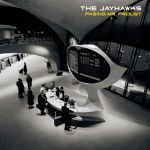 THE JAYHAWKS
THE JAYHAWKSPaging Mr. Proust
There are Jayhawks fans that prefer the alt-country twang that original member Mark Olson brought to the group. But he departed, for the second time, in 2012, again leaving the Minneapolis folk-rock band in the capable hands of singer-songwriter Greg Louris. Four years later The Jayhawks take wing with an effortlessly melodic album that mostly shirks the country inflections of their 1995 masterwork Tomorrow the Green Grass. Instead, Louris and his cohorts straddle power pop, folk, rock and all the myriad sub-genres in between. The harmonies are sublime. From the Wilco-esque ‘Comeback Kids’, to the Teenage Fanclub-esque opener ‘Quiet Corners & Empty Spaces’ and the breathtaking closer ‘I’ll Be Your Key’, Paging Mr . Proust demands repeated listens.
 NADA SURF
NADA SURFYou Know Who You Are
New York City’s alt-rock heroes Nada Surf make a triumphant return on You Know Who You Are, their first album in four years. ‘Cold to See Clear’ kicks into a familiar gear; pretty and heavy. But from the stomping first track the distortion softens and they demonstrate their power pop prowess, crafting 10 dreamy tracks of jangled guitars and sugar-sweet harmonies. Singer and guitarist Matthew Caws channels the sweetness of Roger McGuinn and, more than ever, sounds like a Teenage Fanclub alumni. If you love top-shelf power pop (you know who you are) then you should part with some cash for this album.
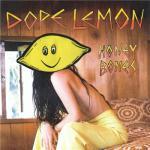 DOPE LEMON
DOPE LEMONHoney Bones
In June this year Angus Stone finally got around to dropping the breezy bedroom project he’d been slowly piecing together over many years. The result is, as the name suggests, pretty dope. In fact, at about the mid-point of opener ‘Marinade’, the idea that this is Stone’s finest work doesn’t seem all that big a claim. Stone manages to out-slack Kurt Vile with a cohesive psych-folk collection that’s so dreamy it’s on the brink of deep slumber. There’s some sweet experimentation too, with drops of trip-hop on ‘The Way You Do’ and shimmering dream-pop on the exquisitely serene ‘Won’t Let You Go’. They’re zesty elements in an always interesting and catchy record that expands and unfolds with repeated listens, and is a perfect marriage with Stone’s laconic vocals. Dope Lemon is a project worthy of further exploration – let’s hope it’s not a one off.


Best albums of 2016… so far

William Crighton
At the halfway point of 2016, the music world has been rejoicing and mourning in equal measure. It’s been one of the best years for new music in a decade, yet the achievements of the world’s songwriters stand in the long shadow cast by a series of departed superstars. Giants like David Bowie, Merle Haggard and Prince have stepped into the wings after their final encore.
As we remember the contributions of those legends, let’s also indulge in some ripe new produce. Here are some of the best records of 2016 so far.
 DAVID BOWIE
DAVID BOWIEBlackstar
David Bowie’s final studio record became a theatrical magic trick worthy of Labyrinth‘s Goblin King. Upon his death, which caused widespread devastation, the themes embedded in the envelope-pushing Blackstar took on new meaning. Viewed through the prism of a man aware of his impending departure, the album is the trailblazing legend’s final musical statement – as stunning, esoteric and deliciously brazen as Bowie’s fans could have hoped for. Now we wait for the inevitable swathe of unreleased material.
 THE DRONES
THE DRONESFeelin Kinda Good
When The Drones release a new album, it’s best to expect the unexpected. Feelin Kinda Good delivers on the band’s early promise of not just pushing the sonic envelope, but also gleefully desecrating every modern music convention they can get their greasy paws on. Here, on their seventh record, songwriting mastermind Gareth Liddiard’s acid tongue is as voracious and verbose as ever, twisting around enough subjects to fill a volume of the Funk and Wagnalls. He spits rhymes in compelling rhythms, more rapper than rocker. Bassist Fiona Kitschin’s eerie vocals add beauty, albeit unsettling beauty, to the discordant throbs of keyboards and demented instrumentation. This is The Drones at their most weird and wonderful. They remain Australia’s best band.
 WILLIAM CRIGHTON
WILLIAM CRIGHTONWilliam Crighton
It’s an increasingly rare feeling to break bread with a record that feels legendary – and isn’t 40 years old. But William Crighton’s debut effort is indeed one of those elusive modern classics, a stirring and powerful songbook with literary ambition.
This collection of tunes that spans alt-country, rock, and psych-folk – with poetic flair – taps into Australian culture and then sets its gaze further, as Crighton ruminates on mortality and the broader human experience. The tracks sometimes feature murder and suicide, and then tip to the other end of the emotional spectrum: love and loyalty. William Crighton is sure to prove the most exciting discovery of 2016 for a great many discerning music lovers. Any “best of the year” list void of this album has been compiled by a hack.
 MYSTERY JETS
MYSTERY JETSCurve of the Earth
In 2008, lots of Aussies discovered Twickenham indie-pop group Mystery Jets when their twee duet with Laura Marling, ‘Young Love’, became a hit on Triple J. The tune, while irresistibly catchy, was very much of its time – cute, minimal and… well, cute. But since then the band, led by angel-voiced Blaine Harrison and his dad Henry (who rocks the keyboards), the band have consciously evolved and crafted increasingly nuanced anthems. That metamorphosis has come to a head on Curve of the Earth, a mammoth prog-pop opus that is hypnotising in its beauty. Perhaps the title suggests the band are on the precipice, at inspiration’s peak, wide-eyed at the possibilities of their sound. The rhythm section hums beneath a wall of glorious synthesiser and rock guitar. It’s decidedly British. It’s decidedly brilliant.
 THE JEZABELS
THE JEZABELSSynthia
The Jezabels fell victim to the brilliance of their debut material. The Sydney quartet’s triptych of EPs indicated they were the future of rock music in Australia. Their sound, buoyed by the ethereal vocals of Hayley Mary, was overwhelmingly emotive and felt dislocated from any trend or definable influence. It was of its own universe.
Their inevitable debut record, and its follow-up, contained singularly great tracks (‘Endless Summer’ an undeniable creation) but there was also a sameness across both albums, as if the band had reached a glass ceiling of innovation that they could not quite break through. On Synthia, the group smash the ceiling to smithereens. Dark, mesmerising, unconventional and otherworldly, Synthia feels like a band that has deconstructed its sound and built into something radiant and towering. It’s the journey we’ve been craving. A promise fulfilled.
 IGGY POP
IGGY POPPost Pop Depression
“Post Pop Depression” is surely what the music world will feel when Iggy snarls and spits his way off the end of this mortal coil. But, in the meantime, we can bask in the twisted machismo of one of the last living punk legends. Pop has long waded through the swamp of man’s nature, and on Post Pop Depression he finds a suitable modern adventurer with whom to frolic. The leathery warlock is front and centre – exactly where he should be – but Queens of the Stone Age captain and Kyuss alumni Josh Homme is behind the screen, orchestrating this dark and masculine theatre. The result is a beautiful fusion of both their sensibilities – Pop’s dulcet delivery and red-blooded poetry dancing with Homme’s cinematic, inventive arrangements and kinky riffage.
 THE BESNARD LAKES
THE BESNARD LAKESA Coliseum Complex Museum
With an album title that should sufficiently tickle prog-rock fans in their giblets, The Besnard Lakes return with their fifth interstellar excursion. A Coliseum Complex Museum doesn’t exactly take the Montreal six-piece boldly where no Besnard album has gone before. But whatever lack of self-imposed invention the album may harbour, ACCM is too shimmering, catchy and radiant to avoid repeated listens. For a band named after a still body of water, their echoey wall-of-sound rises and crashes in glorious waves. High vocals and reverb-drenched guitars hint at alt-country, power pop and prog influences, but the ingredients are melted down into a lysergic kaleidoscope that is unmistakably the work of The Besnard Lakes. Closer ‘Tungsten 4: The Refugee’ is one of the best songs of 2016.
 MELODY POOL
MELODY POOLDeep Dark Savage Heart
It’s shaping up to be Melody Pool’s year. The Kurri Kurri-raised, Melbourne-based songwriter has made a stirring creative statement on Deep Dark Savage Heart, an inspiring and always arresting songbook of strength and sensuality.
Pool’s impressive debut album The Hurting Scene, released three years ago, was forged in the flames of heartbreak. The pain-laced lyrics were those of a young woman not just suffering the loss of someone she loved, but the suffocating sting of betrayal. Cathartic and aching, the album’s centrepiece, ‘Henry’, was a mature and fatalistic distillation of her anger and hurt. But, conversely, The Hurting Scene‘s radiant melodies and arrangements were invariably upbeat, belying the emotional weight within.
Deep Dark Savage Heart is a far different beast. It’s a dark folk record, cast in shadowy minor chords, and a work of staggering beauty. The arrangements and melodies dance and twirl beneath the moonlight in a synergic embrace.
Full review here.
 THE JAYHAWKS
THE JAYHAWKSPaging Mr. Proust
There are Jayhawks fans that prefer the alt-country twang that original member Mark Olson brought to the group. But he departed, for the second time, in 2012, again leaving the Minneapolis folk-rock band in the capable hands of singer-songwriter Greg Louris. Four years later The Jayhawks take wing with an effortlessly melodic album that mostly shirks the country inflections of their 1995 masterwork Tomorrow the Green Grass. Instead, Louris and his cohorts straddle power pop, folk, rock and all the myriad sub-genres in between. The harmonies are sublime. From the Wilco-esque ‘Comeback Kids’, to the Teenage Fanclub-esque opener ‘Quiet Corners & Empty Spaces’ and the breathtaking closer ‘I’ll Be Your Key’, Paging Mr . Proust demands repeated listens.
 NADA SURF
NADA SURFYou Know Who You Are
New York City’s alt-rock heroes Nada Surf make a triumphant return on You Know Who You Are, their first album in four years. ‘Cold to See Clear’ kicks into a familiar gear; pretty and heavy. But from the stomping first track the distortion softens and they demonstrate their power pop prowess, crafting 10 dreamy tracks of jangled guitars and sugar-sweet harmonies. Singer and guitarist Matthew Caws channels the sweetness of Roger McGuinn and, more than ever, sounds like a Teenage Fanclub alumni. If you love top-shelf power pop (you know who you are) then you should part with some cash for this album.
 DOPE LEMON
DOPE LEMONHoney Bones
In June this year Angus Stone finally got around to dropping the breezy bedroom project he’d been slowly piecing together over many years. The result is, as the name suggests, pretty dope. In fact, at about the mid-point of opener ‘Marinade’, the idea that this is Stone’s finest work doesn’t seem all that big a claim. Stone manages to out-slack Kurt Vile with a cohesive psych-folk collection that’s so dreamy it’s on the brink of deep slumber. There’s some sweet experimentation too, with drops of trip-hop on ‘The Way You Do’ and shimmering dream-pop on the exquisitely serene ‘Won’t Let You Go’. They’re zesty elements in an always interesting and catchy record that expands and unfolds with repeated listens, and is a perfect marriage with Stone’s laconic vocals. Dope Lemon is a project worthy of further exploration – let’s hope it’s not a one off.


May 16, 2016
Coheed and Cambria: live review
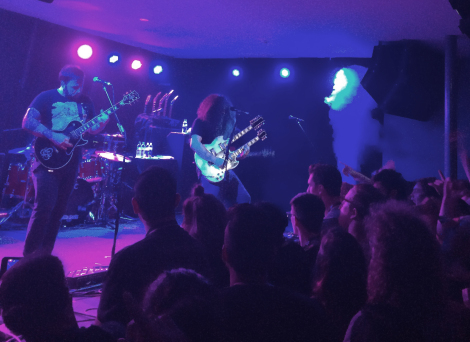
Coheed and Cambria shake The Cambridge Hotel in Newcastle.
COHEED AND CAMBRIA
The Cambridge Hotel
Monday, May 9, 2016
When lyrics are screamed at rawk shows, vaulting a sea of raised fists, they tend to share a common trait. Take, for example, AC/DC’s timeless weather report, ‘Thunder! Na na na na naaaaa na naaa na na!” or Van Halen’s half-hearted fitness message, “Might as well JUMP!” These micro-poems are simple, memorable and, most importantly, easily slurred at a sizeable concert or around the pool table at your local swill shack.
It’s strange, then, to hear a room of sweaty and jubilant Novocastrians scream the verbose call-to-arms, “Man your own jackhammer! Man your battle stations!” But this is not AC/DC and it’s certainly not Van Halen. In fact, the ethos of New York City’s Coheed and Cambria could not be further removed from your typical arena rock band. Where other purveyors of devil-horned riffage and seismic rhythm sections have focused their lyrics on fast women, war, the supernatural, and the woes of society’s impoverished underdogs, singer and guitarist Claudio Sanchez has explored life through the prism of a hard sci-fi universe, one in which he is the visionary architect.
The length and breadth of the 90-minute earth-shattering performance is matched only by the cascading and voluminous grandeur of Sanchez’s hair.
As the range of graphic novels for sale at the Cambridge Hotel’s merch desk illustrates, Sanchez is a literary storyteller. With the exception of Coheed’s most recent record, last year’s The Color Before The Sun, the lyricist has been weaving an expansive narrative, called The Amory Wars, across eight epic prog-rock albums. The best records among them require a deep breath before each title’s recital: Good Apollo, I’m Burning Star IV, Volume One: From Fear Through the Eyes of Madness and Good Apollo, I’m Burning Star IV, Volume Two: No World for Tomorrow. The Amory Wars is overflowing with original characters and weaves a mythology not easily summarised in a brief review for Newcastle Live! – but, take it from me, those first eight albums are a scintillating mix of sequels and prequels.
In Australia, Coheed and Cambria have remained something of a cult phenomenon amongst discerning music purists. True to their “progressive” nature, they invariably write large pieces of rock opera segmented into different movements. Their arrangements tend to bend the mind, often shifting time signatures and dynamics, and assert Sanchez’s prowess as a conjurer of classic rock and metal pieces that don’t shy away from shiny pop melodies. The release of their 2002 debut, The Second Stage Turbine Blade, saw them ride the popularity wave of emo, post-rock and pop-punk to our shores but, truth be told, they are a different beast entirely to the likes of Taking Back Sunday, The Used and Thursday. When that emo wave eventually reached its trough, fans of classic rock and metal continued to carry Coheed’s torch and the band has continued to visit Oz, including a Soundwave festival appearance.
Their Newie fans (“Cambrians”?) are out in force tonight, the room coloured with the band’s stunningly rendered T-shirt art and VIP lanyards, the latter awarded to those who paid top dollar for a special fan package that included a private soundcheck performance and meet and greet with the band.
Sufficiently aroused by Coheed’s go-to Aussie support act Closure in Moscow, who are a groovier version of their New York City brethren, the Cambridge’s crowd voice their excitement when Sanchez and long-time guitarist Travis Stever step on stage for ‘Ghost’, a haunting acoustic ballad off their recent record. Then drummer Josh Eppard and bassist Zach Cooper appear from the wings as Sanchez picks up one of his jagged electric axes and plays the foreboding opening notes that announce the eight-minute fan favourite In Keeping Secrets of Silent Earth: 3, the title track off their 2003 album and harbinger of the aforementioned “battle stations” chant. Recorded, the song is mighty. But live, the sprawling classic is a monstrous and euphoric composition.
Coheed march forward and throw a molotov cocktail of old (‘The Crowing’, ‘A Favor House Atlantic’, ‘Blood Red Summer’) and new (‘Island’, ‘Here to Mars’) tracks, treating their eager fans to a show of arena proportions. The length and breadth of the 90-minute earth-shattering performance is matched only by the cascading and voluminous grandeur of Sanchez’s hair. His voice, piercing in range and timbre, is in full flight, though the singer often steps back from the microphone to let the crowd wail their favourite parts. And, while ably supported by Eppard and Cooper, the effortless guitar work of Sanchez and Stever steals the show, each possessing blistering speed and intricacy when called upon to drop a solo.
Sanchez is not a big conversationalist on stage, preferring to let the music do the talking, but he does pause momentarily to praise Newcastle. Stever gushes that the locals they met during their day in our city were some of the “nicest people they’ve ever come across”, and reveals the band stopped by two Newie institutions – the Rock Shop and Graphic Action Comics (Sanchez gives the latter a shout out on his Instagram the following day).
A highlight of the remaining set is ‘No World for Tomorrow’, one of the band’s finest tracks. It’s the ultimate example of the dizzying rock heights of which the band are capable of reaching. Soon after, when the rockers eventually leave the stage, a deafening “COHEED” chant slowly lures them back for an encore. After another sincere thank you from Sanchez, the quartet launch into new song ‘You’ve Got Spirit, Kid’, a really old song ‘Everything Evil’ and then ‘Welcome Home’, the anthem for which Newie fans would surely hold them hostage until they played. It’s twin lead guitar finale is a white-knuckled, edge-of-your-seat crescendo to one almighty evening of rawk.
With ears ringing and smiles emblazoned from ear to ear, disciples reluctantly depart, left to wonder if the building may crumble around them.
The Cambridge still stands, but not for Coheed and Cambria’s lack of trying.





